

Free Middle School Book Report Template
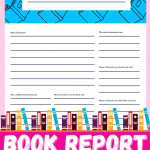
Looking for a middle school book report template that’s engaging and effective? You’re in the right place.
My son loves reading but despises writing. To encourage him, I created a fun and free book report template that he now enjoys using.
This simple tool has transformed our homeschooling experience, turning his reluctance into enthusiasm.
These free homeschool printables aren’t just for homeschoolers. They’re perfect for classrooms too, offering a structured way to summarize and reflect on books.
The sections include a story summary, favorite and least favorite characters, personal opinions, and setting details, simple yet effective prompts to boost reading comprehension and writing skills.
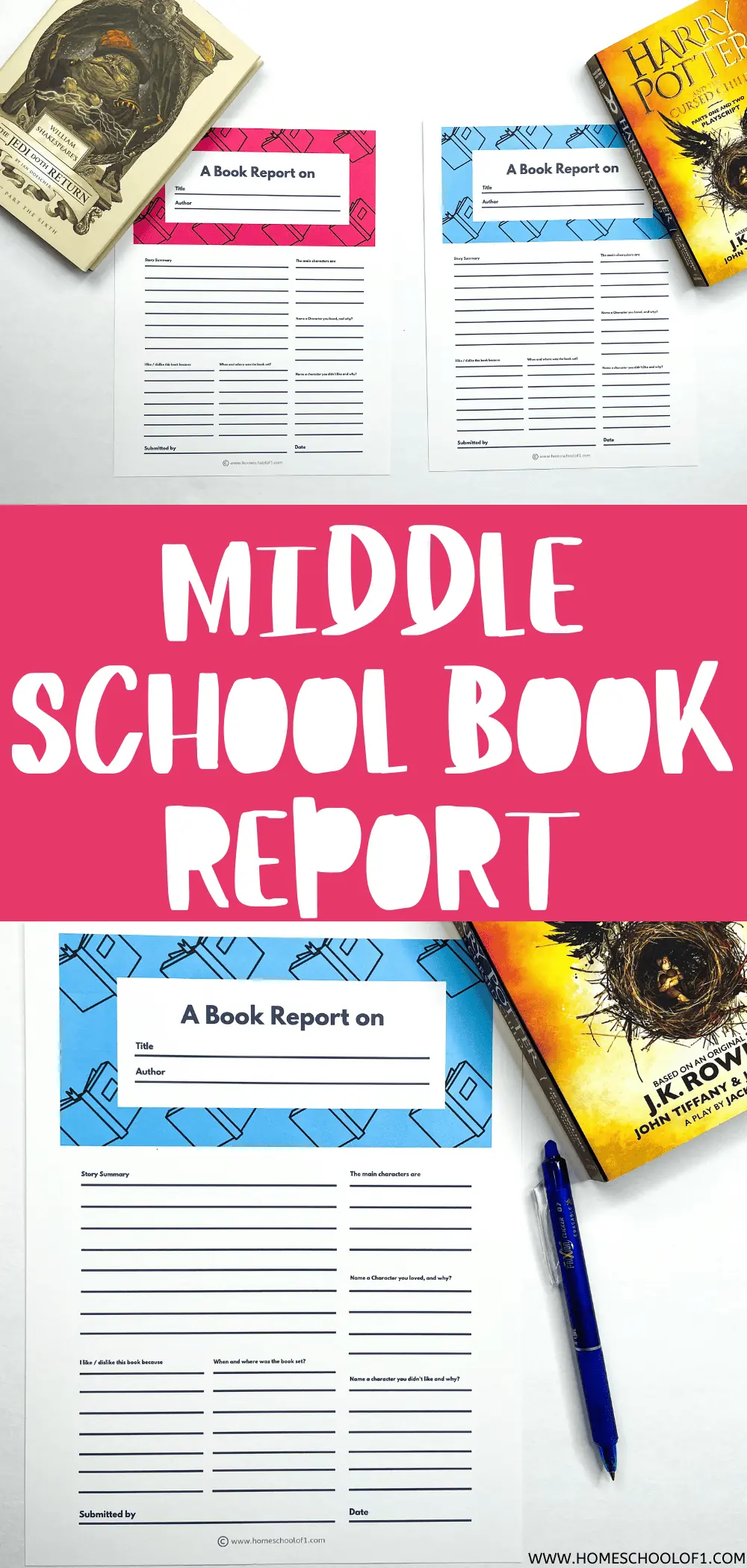
**There may be affiliate links in this post. You can read my full disclosure at the bottom of the page.**
Table of Contents
Why use a book report template?
Book reports help with reading comprehension and writing practice, essential skills for middle school students.
By encouraging students to think critically about what they read, these templates foster deeper engagement with the text.
Let’s dive into why these templates are so beneficial for students across various grade levels and how they align with core standards in language arts and literacy.

Enhancing reading comprehension
The main reason for using book reports is to improve reading comprehension.
By breaking down the story into manageable parts, students can better understand the plot, characters, and themes.
This methodical approach encourages them to think deeply about the text, which is crucial for developing literacy skills.
This is especially important for middle school students who are transitioning from elementary-level reading to more complex texts.
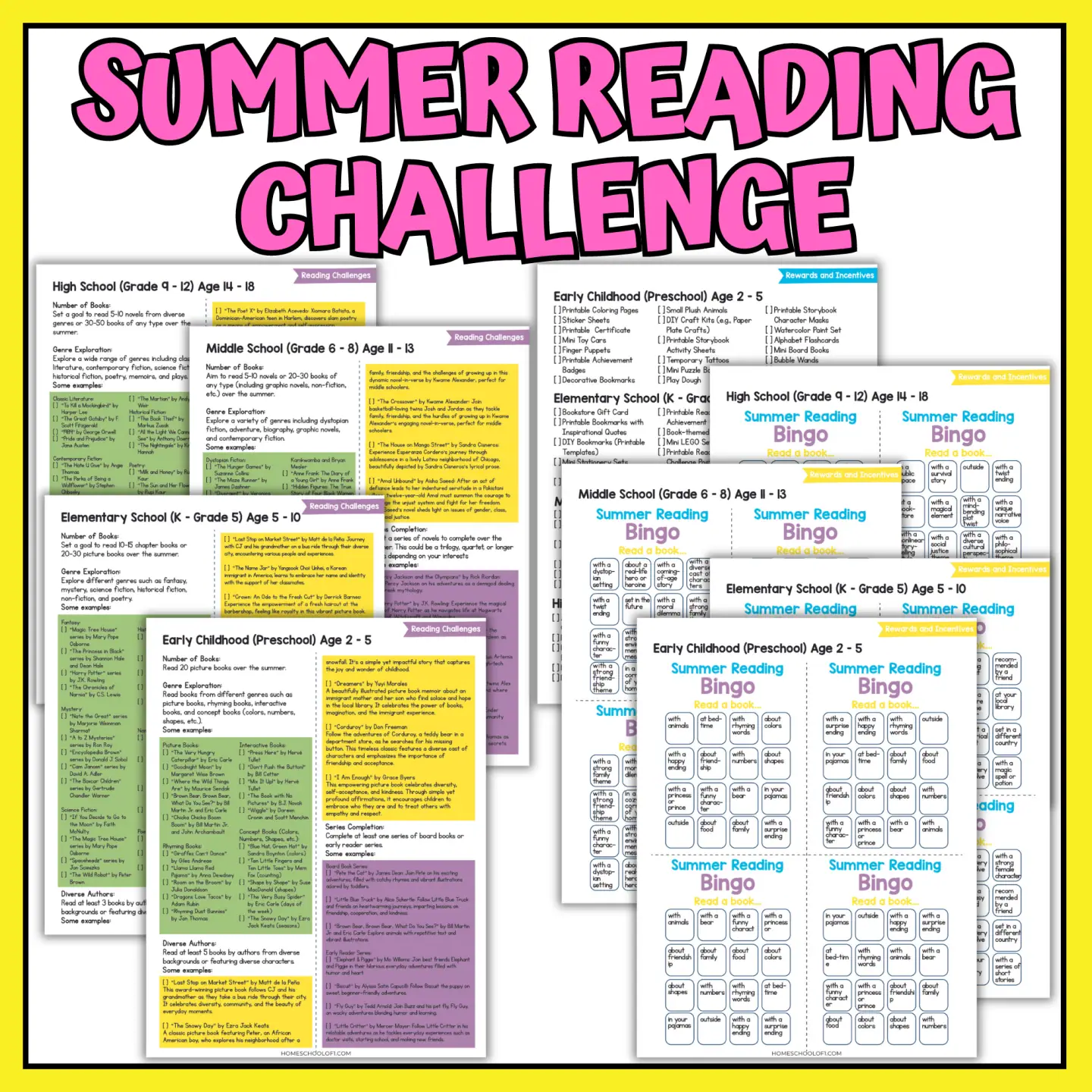
ENJOY A SUMMER OF FUN WITH OUR READING CHALLENGE!
Integrating writing skills.
Writing a book report also integrates writing skills into the reading process.
Students must organize their thoughts, summarize the story, and express their opinions clearly.
This not only helps with writing fluency but also reinforces grammar and punctuation rules.
For students struggling with writing, like my son, this can be a gentle and effective way to practice.
Meeting educational standards
Our book report templates are designed to meet common core standards for English language arts.
They provide a structured way for students to engage with the text, ensuring they meet grade-level expectations for comprehension and writing.
These templates are suitable for various grade levels, from upper elementary to middle school, making them versatile tools for teachers and parents.
What’s included in the template?
Our book report template is simple yet comprehensive, covering key elements of a story. Here’s what’s included:
- Story Summary : A brief overview of the plot. This helps students practice summarizing, an essential comprehension strategy.
- Main Characters : Descriptions of key characters. Understanding characters is crucial for analyzing their actions and motivations.
- Character Preferences : A character you loved and one you didn’t, with reasons why. This encourages critical thinking and personal reflection.
- Book Evaluation : What you liked or disliked about the book. Expressing opinions helps with articulating thoughts and improving persuasive writing skills.
- Setting : Where and when the story takes place. Recognizing the setting enhances understanding of the story’s context.
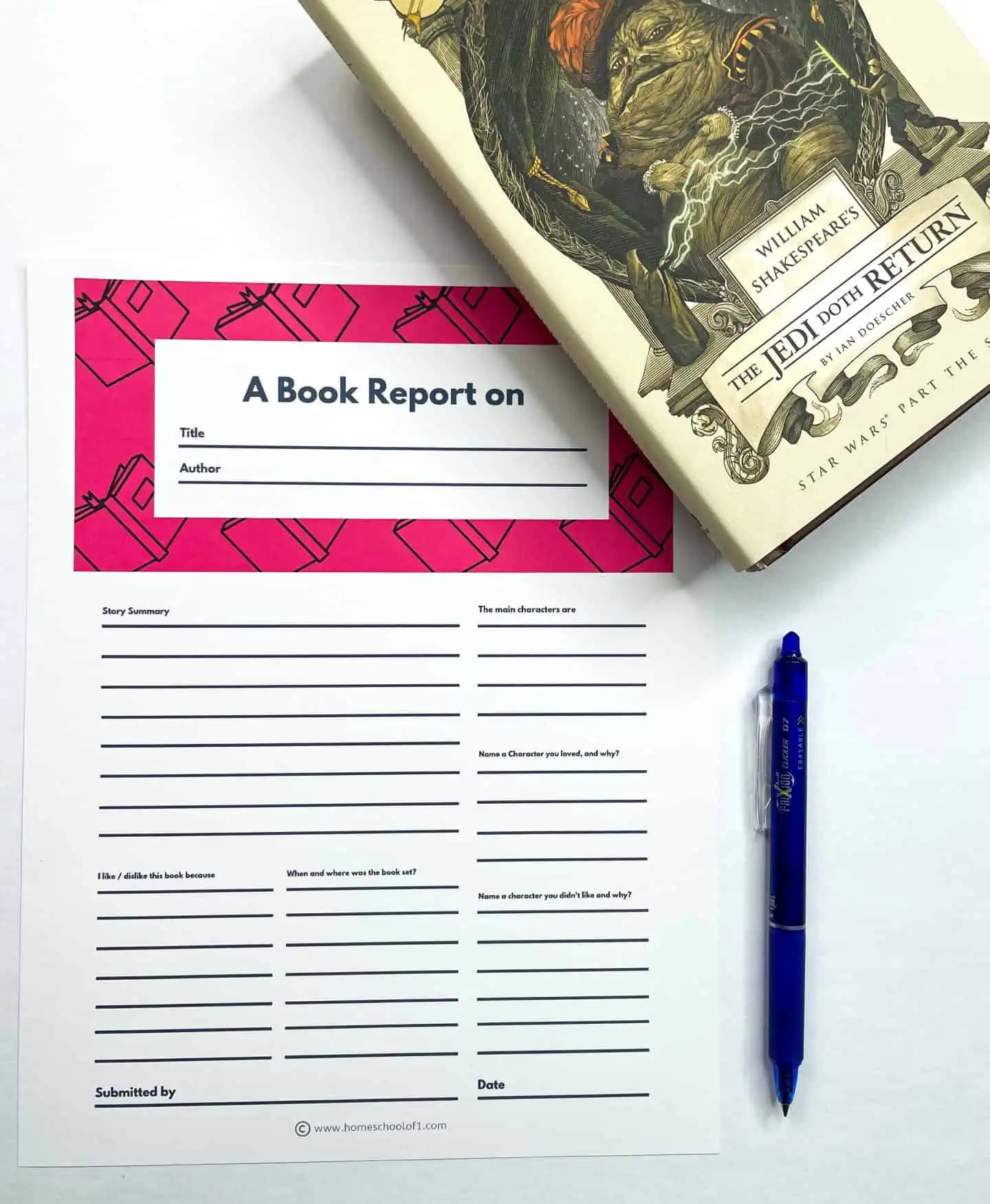
Additional resources
In addition to our book report template, we offer several other resources to support literacy and comprehension:
- Reading log printable : Track reading progress with this handy log. It encourages consistent reading habits and helps students set and achieve reading goals.
- Compare and contrast movie and book template : For book-to-movie adaptations. This encourages critical thinking by comparing different media formats.
- Summer reading bingo printable : A fun way to motivate children to read a variety of genres. Completing a bingo card can earn small prizes, making reading a rewarding activity.
- 3rd grade book report template
How it works in our homeschool
My son now voluntarily writes a book report after finishing each book, a task he once dreaded.
We add these reports to his homeschool portfolio, documenting his reading journey and improving his writing skills.
This transformation was a turning point in our homeschool experience, showcasing the power of engaging educational tools.

Versatility for different grade levels
While our template is ideal for middle school students, it’s also adaptable for other grade levels.
For younger students, like those in 3rd or 4th grade, we offer a simpler version to suit their developmental stage.
As students progress to higher grades, the template can be expanded to include more detailed analysis, preparing them for high school and beyond.
Incorporating into lesson plans
Teachers can easily integrate these templates into their lesson plans.
Whether for a language arts class, a social studies assignment, or independent reading projects, the template provides a consistent format for students to follow.
It can be used for both fiction and non-fiction books, making it a versatile tool for any curriculum.
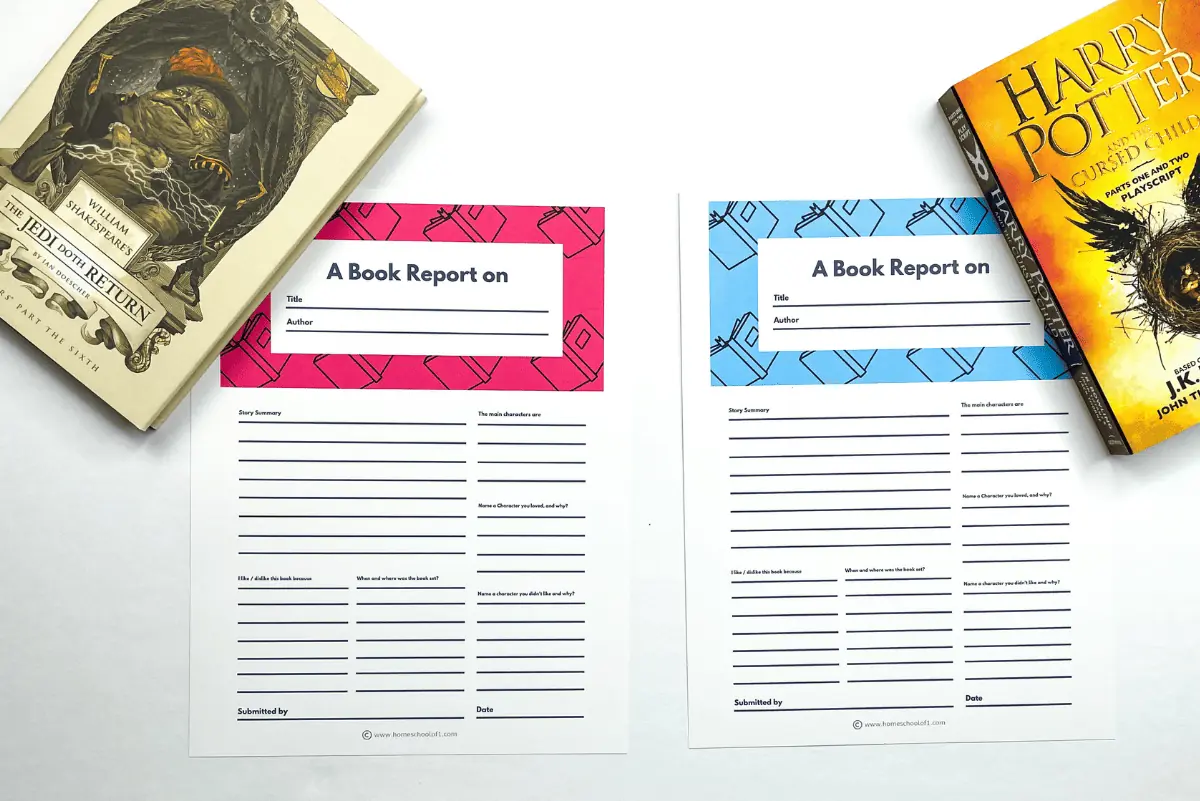
Encouraging independent reading
Independent reading is a key component of literacy development. Our book report template encourages students to read on their own and think critically about what they read.
By providing a clear structure, it helps students focus their thoughts and improve their reading comprehension.
Check out our favorite books for 13 year old boys .
Supporting struggling readers
For students who find reading challenging, like those with dyslexia or other learning difficulties, this template can provide much-needed support.
Breaking the book down into smaller sections makes it less overwhelming and helps them focus on understanding each part. Incorporating book discussion questions into the process can further enhance their comprehension and engagement.
Teachers and parents can use the template as part of a broader reading intervention strategy to help these students succeed.
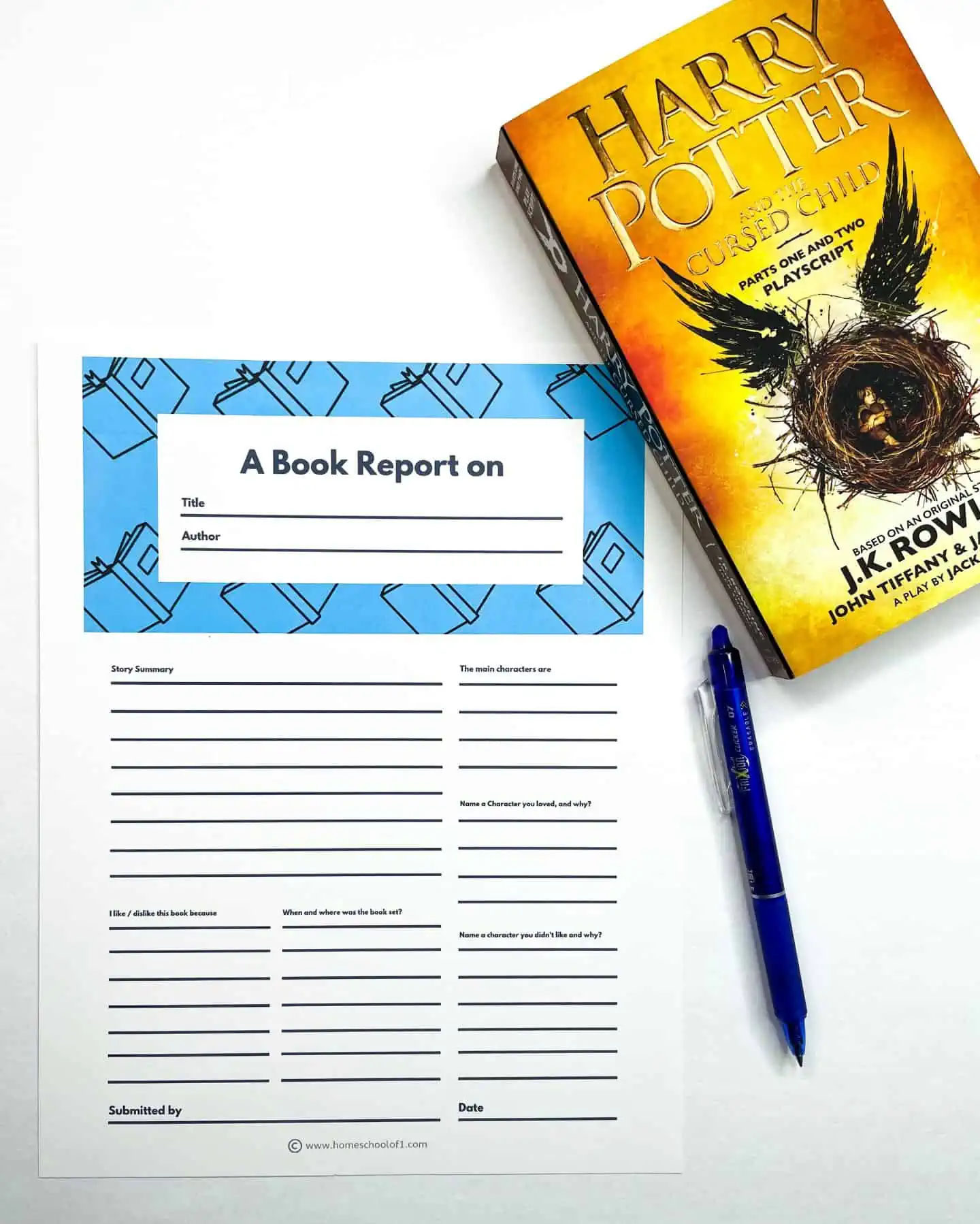
Printable and easy to use
Our book report template is designed to be user-friendly. It’s printable, making it easy for teachers to distribute in classrooms or parents to use at home.
The clear layout guides students through the process, ensuring they don’t miss any important elements.
Free download and personal use
We believe in making education accessible, which is why our book report template is free to download. It’s available for personal and classroom use, ensuring that all students can benefit from this valuable tool.
Simply enter your email address at the bottom of this post to receive the PDF file.
Download the free printable book report templates
Make sure you choose the correct paper size and click on the shrink to fit button. All of our free printables for kids work better when printed on cardstock (this is the one we use and love.)
Last Updated on 25 June 2024 by Clare Brown
Leave a Reply Cancel reply
Your email address will not be published. Required fields are marked *
WTO / Education / 30 Free Book Report Templates – How to Outline (Format)
30 Free Book Report Templates – How to Outline (Format)
A book report template is a document that contains a general layout or format that your book report fits into efficiently and it facilitates you in completing it by following the correct pattern that is required for it to be considered of a credible nature.
It is a written essay that summarizes a specific book’s contents and composition, such as the plot, characters, title, tone, and setting of the story.
A template for it may also contain information about the author or an evaluation of the good and bad aspects of the book.
A book report is a typical assignment for students throughout their school years, whether in elementary, middle, or high school. The report serves as a method to show that the students have read the book adequately and in its entirety.
Free Book Report Templates
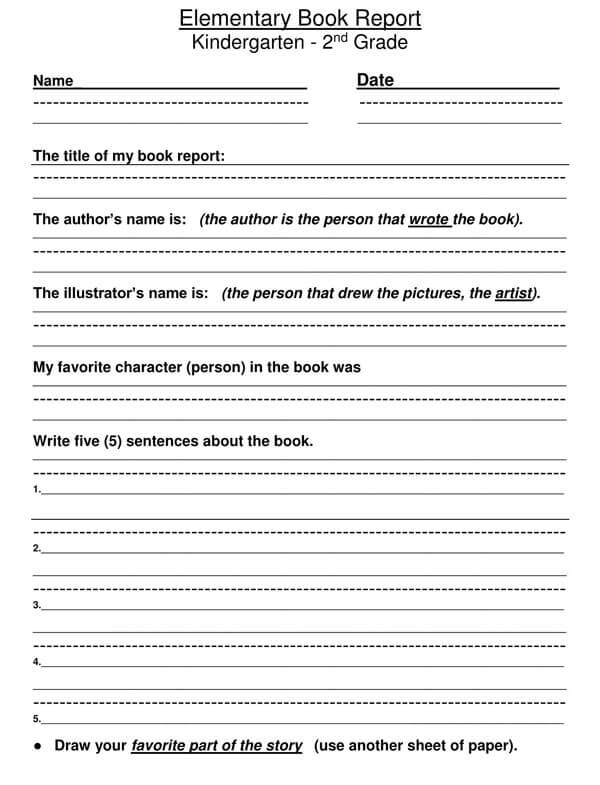
Book Report vs. Book Review
A book report is an objective view of a specific book where you will be describing the general plotline without giving extensive details, analysis, or opinions of the student. It usually only states facts about the book’s contents without the need to assess this content.
On the other hand, a review is a subjective view. It will require evaluating the main ideas contained within the book and analyzing them, giving their ideas and thoughts about the plot. A review serves to give an idea of whether the book would interest prospective readers.
The book report and review are similar in certain aspects, such as
Background information
- Target audience
Subject and thesis statement
- Summary of content
Bibliographical information
Essentials of a book report.
Regardless of the type or subject of the book that the report is written about, certain elements are required in each template.
The elements of a good template are:
The template will need to contain information about the author’s work to write the book. This information includes the author’s name, the title of publication, the book’s date of publication, the place of publication of the book, the publisher of the book, the volume of the book, and page numbers.
The background information is the main bulk of the book, which gives it its unique aspects and drives the readers to be interested in the book.
The background information includes:
An exploration of the characters is required for the report; the significance of the characters and how they affect the plot should also be stated. A brief exploration of their personalities and actions might be required.
The setting refers to the time and place where the events occur. The setting is an integral part of the plot and is essential in driving the story forward, so the author needs to pick the setting carefully. Therefore, the writer of the report needs to inform the reader about the setting and give an idea of how it improves upon the story.
The theme is the idea that recurs within the book, and it is the idea that the author focuses on throughout the plot. The theme of the book needs to be broadly explained. Discuss the aim of the book and the prevalent ideas within. It is preferable if you use sections and examples to reinforce it.
A book report will require a summary of the plot. The summary will retell the story more concisely while explaining the main points of the plot. In addition, the teacher might require an analysis of the events of the plot to show an adequate understanding of the events. The use of examples taken from the book during the analysis will improve its quality.
Compare and contrast
Compare the book to other books within the same genre. Show how the settings, characters, and themes might mimic or contrast against each other. Elaborate on how this might enrich the content. Also, mention what your thoughts are regarding both and which combination works best.
Intended audience
Each book has an intended audience that the author wants to appeal to, inspire, and talk to. Mention who the intended audience is and how you came to this information. The audience can be directly stated by the author or can be concluded from the manner of writing. It is essential to know who the audience is, as they will affect how the books are received, the themes and setting of the book , and the level of sophistication of the language used.
The overall subject of the book should be mentioned, indicating what it aims to deliver by the end of it. The author’s thesis statement, which is usually a brief paragraph, should be written either in the author’s own words or from your conclusion.
Summary of the content
The summary is a brief retelling of the most important events, ideas, and characters within the book. The summary usually doesn’t need to exceed 300 words.
Free Templates
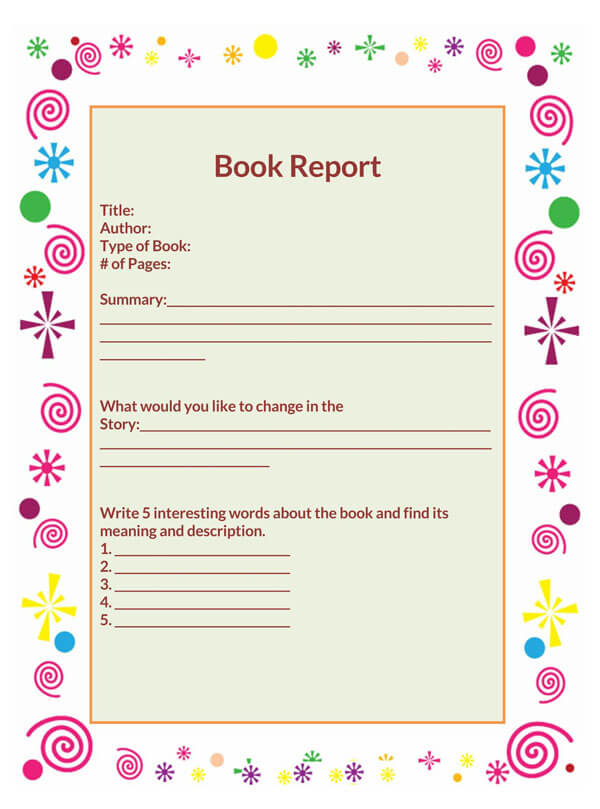
Types of Book Reports
The type depends on the focus of the report and on which aspects of the book you will focus on. You can sometimes choose the type, or it is assigned to you by the teacher.
There are three main types of book reports, and these are:
Plot summary
A plot summary is an analytical method of retelling the story. Analyze the events and give your ideas on how the plot is improved or rendered worse by the different elements of the plot. Always quote parts of the book and give examples to reinforce your points about the plot.
Character analysis
This takes a character (or multiple characters) and shines the spotlight. Analyze the character, their personality traits, and how they interact with other characters. The importance of character in the story and how it drives the plot forward. Also, analyze how the character talks and acts and what their goals are. Give criticism of whether this character is relatable, which aspects improve the character, and any other personal opinions you may have.
Thematic analysis
Writing an analysis of the book’s theme can be a difficult task. It will require a deep understanding of the overarching narrative and the ability to see what the author is attempting to convey through the book. Write an exact explanation of the theme of the book, explaining it thoroughly. Then, please write your personal opinions regarding the theme, how it adds or subtracts from the book, and whether you found it fitting. Bring in examples from the book and explain them one by one to make your point even clearer.
How to Outline a Book Report Template
The outline is the frame of the report you will write down your information in according to the outline.
It is made up of three parts, and they are
The introduction
Start by introducing the title and the author. You can mention a brief history of the author, such as their previous publications. You should also introduce the theme and ideas that the book aims for and give any reasons why you chose this book to write a report about. You can also add information regarding the publication of the book, how it was received by the readers, whether the book is famous or not, and so on.
The main body
This is the most critical part, where you’ll need to describe the plot of the book and set it concisely, focusing on the important events and characters while analyzing them. Give your personal opinions to make the report more specialized. You can even give examples and comparisons taken from other books.
The main body of a template will include:
- Summary: a description of the events of the book, the characters, the setting, and the plot of the book. The reader should have a clue of what the story will provide by the end of this summary.
- Character details: talk about the characters, the relationships between them, and any conflicts.
- Plot analysis: Explain the main events of the plot without going into extensive details. Explain the strengths and weaknesses of the plot while also mentioning any literary devices.
Conclusion and personal evaluation
Write down your final thoughts and ideas regarding the book: how it made you feel, how it can be improved, and what ideas it gave you. Reading a book can leave an impression on a person; talk about the impression you received from the book and your evaluation.
Free Downloads
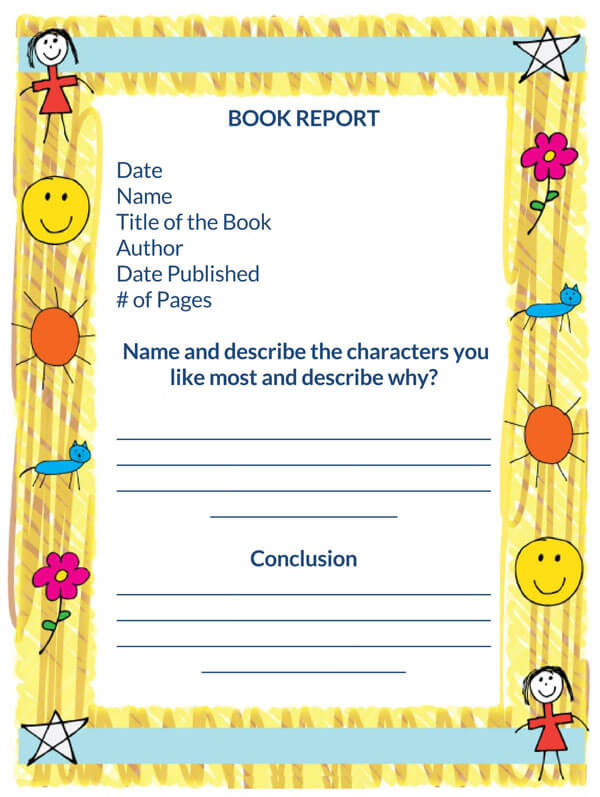
How to Write a Book Report
There are steps to be taken before writing the report to facilitate the process and improve the overall result of the work that you put into the report.
These steps are:
Pick the book carefully
If you choose to pick which book to write the report about, choose one that connects to you and interests you the most. Choosing one you’re passionate about will aid in the process of writing the report. But if you were assigned the book and are unable to change it, then keep an open mind. Maybe you will like it.
Proper reading of the book
Read the book thoroughly and with focus; writing the report will require a good understanding of various parts to explain them within the report. Therefore, it is important to give it a proper read, as you will not write a good report without knowing it well. Consider reading complicated sections more than once for a more proper understanding.
Jot down notes
While reading, note the important events, characters, and plot points you would want to discuss. This will help make writing faster and easier and encompass the book’s various parts.
Organize your notes
Choose which of your most important notes you will be talking about first. The book report is usually of a limited length, so you will probably need to cut back on some notes. Give priority to the most important notes that you think will help you stand out, such as the ones that talk about significant events or the ending as an example.
Create an outline
The outline is similar to the frame of a painting. It will help you stay focused on the essential parts. Therefore, you must create an outline before you start working. You can write down the outline on paper or within the document itself before working. This will give you a clear idea of what you’re going to write about and facilitate the process of writing.
Begin reiterating the story
One of the most critical aspects is how you retell and summarize the story. First, decide how you will approach the story, its length, and which events are discussed. Secondly, decide on your approach to these events and how you’ll describe them, whether in detail, from the point of view of a particular character, or as an observer.
Be creative with the way you reiterate the story and add your personal touch whenever possible to help the report stand out.
Write your book report
Finally, you can start writing your report. Focus on your notes and follow the outline. Finish writing the main body, then give your analysis.
Tips for Writing a Book Report
There are a few aspects of writing a book report that are only learned with practice and experience. Unfortunately, new writers make common mistakes.
Follow these tips to avoid such common mistakes :
Avoid cramming
Writing is a time-consuming process that is better done slowly. Cramming and forcing yourself to write the report on short notice will negatively affect the report and be noticeable. Instead, plan your time and work while you are relaxed and have plenty of time.
Get a dictionary
Reading with a dictionary by your side will help you with those pesky words that you don’t know the meaning of. It is important to have a better understanding of the story and the author’s method of writing, which in turn helps improve your report.
Read existing reports on the book
Sometimes, if the book is incredibly daunting to tackle for writing about, you should check other reports regarding it; doing this type of research will give you an idea of what points you should discuss and might even give you some insight that you have missed during your reading.
Get professional writing assistance
Using a writing service that will follow your notes and write a report made just for you can help you when you cannot write it yourself.
Use a template
Using a template like the one we offer will help you make the process faster. You will avoid the need to outline yourself and save time to focus on the other parts of the report.
Format of the Book Report
A specific format should be followed to ensure that the report covers all the necessary aspects. Learn this format and make your notes to improve it and reduce the need for a secondary reading of the book.
This format includes
- The title, the author’s name, and the number of pages.
- The genre and the general theme
- The characters with a brief description of each.
- The setting of the book
- The plotline, the critical events, and a summary.
- Theme and message.
- Your evaluation and opinions.
Frequently Asked Questions
To write one for high school, you need to give a brief introduction of the author, explain the plot and the major characters and events, and give a brief evaluation of the book.
When writing one for the college level, a deeper understanding of the literature is often required. So, first, write down the introduction, including the bibliographic information. Then explain the narrative of the plot, events, twists, and conclusion. Finally, give a summary while also mentioning the strong points or the parts that didn’t work so well.
About This Article

Was this helpful?
Great! Tell us more about your experience
Not up to par help us fix it, keep reading.

12 Free Kindergarten Newsletter Templates

12 Perfect Examples of Salutatorian Speech

12 Free Yes No Flowchart Templates (PowerPoint)

10 Free Homeschool Report Card Templates
Thank you for your feedback.
Your Voice, Our Progress. Your feedback matters a lot to us.

How to Write a Book Report
Use the links below to jump directly to any section of this guide:
Book Report Fundamentals
Preparing to write, an overview of the book report format, how to write the main body of a book report, how to write a conclusion to a book report, reading comprehension and book reports, book report resources for teachers .
Book reports remain a key educational assessment tool from elementary school through college. Sitting down to close read and critique texts for their content and form is a lifelong skill, one that benefits all of us well beyond our school years. With the help of this guide, you’ll develop your reading comprehension and note-taking skills. You’ll also find resources to guide you through the process of writing a book report, step-by-step, from choosing a book and reading actively to revising your work. Resources for teachers are also included, from creative assignment ideas to sample rubrics.
Book reports follow general rules for composition, yet are distinct from other types of writing assignments. Central to book reports are plot summaries, analyses of characters and themes, and concluding opinions. This format differs from an argumentative essay or critical research paper, in which impartiality and objectivity is encouraged. Differences also exist between book reports and book reviews, who do not share the same intent and audience. Here, you’ll learn the basics of what a book report is and is not.
What Is a Book Report?
"Book Report" ( ThoughtCo )
This article, written by a professor emeritus of rhetoric and English, describes the defining characteristics of book reports and offers observations on how they are composed.
"Writing a Book Report" (Purdue OWL)
Purdue’s Online Writing Lab outlines the steps in writing a book report, from keeping track of major characters as you read to providing adequate summary material.
"How to Write a Book Report" ( Your Dictionary )
This article provides another helpful guide to writing a book report, offering suggestions on taking notes and writing an outline before drafting.
"How to Write a Successful Book Report" ( ThoughtCo )
Another post from ThoughtCo., this article highlights the ten steps for book report success. It was written by an academic advisor and college enrollment counselor.
What’s the Difference Between a Book Report and an Essay?
"Differences Between a Book Report & Essay Writing" ( Classroom)
In this article from the education resource Classroom, you'll learn the differences and similarities between book reports and essay writing.
"Differences Between a Book Report and Essay Writing" (SeattlePi.com)
In this post from a Seattle newspaper's website, memoirist Christopher Cascio highlights how book report and essay writing differ.
"The Difference Between Essays and Reports" (Solent Online Learning)
This PDF from Southampton Solent University includes a chart demonstrating the differences between essays and reports. Though it is geared toward university students, it will help students of all levels understand the differing purposes of reports and analytical essays.
What’s the Difference Between a Book Report and a Book Review?
"How to Write a Book Review and a Book Report" (Concordia Univ.)
The library at Concordia University offers this helpful guide to writing book report and book reviews. It defines differences between the two, then presents components that both forms share.
"Book Reviews" (Univ. of North Carolina)
The University of North Carolina at Chapel Hill’s writing guide shows the step-by-step process of writing book reviews, offering a contrast to the composition of book reports.
Active reading and thoughtful preparation before you begin your book report are necessary components of crafting a successful piece of writing. Here, you’ll find tips and resources to help you learn how to select the right book, decide which format is best for your report, and outline your main points.
Selecting and Finding a Book
"30 Best Books for Elementary Readers" (Education.com)
This article from Education.com lists 30 engaging books for students from kindergarten through fifth grade. It was written by Esme Raji Codell, a teacher, author, and children's literature specialist.
"How to Choose a Good Book for a Report (Middle School)" (WikiHow)
This WikiHow article offers suggestions for middle schoolers on how to choose the right book for a report, from getting started early on the search process to making sure you understand the assignment's requirements.
"Best Book-Report Books for Middle Schoolers" (Common Sense Media)
Common Sense Media has compiled this list of 25 of the best books for middle school book reports. For younger students, the article suggests you check out the site's "50 Books All Kids Should Read Before They're 12."
"50 Books to Read in High School" (Lexington Public Library)
The Lexington, Kentucky Public Library has prepared this list to inspire high school students to choose the right book. It includes both classics and more modern favorites.
The Online Computer Library Center's catalogue helps you locate books in libraries near you, having itemized the collections of 72,000 libraries in 170 countries.
Formats of Book Reports
"Format for Writing a Book Report" ( Your Dictionary )
Here, Your Dictionary supplies guidelines for the basic book report format. It describes what you'll want to include in the heading, and what information to include in the introductory paragraph. Be sure to check these guidelines against your teacher's requirements.
"The Good Old Book Report" (Scholastic)
Nancy Barile’s blog post for Scholastic lists the questions students from middle through high school should address in their book reports.
How to Write an Outline
"Writer’s Web: Creating Outlines" (Univ. of Richmond)
The University of Richmond’s Writing Center shows how you can make use of micro and macro outlines to organize your argument.
"Why and How to Create a Useful Outline" (Purdue OWL)
Purdue’s Online Writing Lab demonstrates how outlines can help you organize your report, then teaches you how to create outlines.
"Creating an Outline" (EasyBib)
EasyBib, a website that generates bibliographies, offers sample outlines and tips for creating your own. The article encourages you to think about transitions and grouping your notes.
"How to Write an Outline: 4 Ways to Organize Your Thoughts" (Grammarly)
This blog post from a professional writer explains the advantages of using an outline, and presents different ways to gather your thoughts before writing.
In this section, you’ll find resources that offer an overview of how to write a book report, including first steps in preparing the introduction. A good book report's introduction hooks the reader with strong opening sentences and provides a preview of where the report is going.
"Step-by-Step Outline for a Book Report" ( Classroom )
This article from Classroom furnishes students with a guide to the stages of writing a book report, from writing the rough draft to revising.
"Your Roadmap to a Better Book Report" ( Time4Writing )
Time4Writing offers tips for outlining your book report, and describes all of the information that the introduction, body, and conclusion should include.
"How to Start a Book Report" ( ThoughtCo)
This ThoughtCo. post, another by academic advisor and college enrollment counselor Grace Fleming, demonstrates how to write a pithy introduction to your book report.
"How to Write an Introduction for a Book Report" ( Classroom )
This brief but helpful post from Classroom details what makes a good book report introduction, down to the level of individual sentences.
The body paragraphs of your book report accomplish several goals: they describe the plot, delve more deeply into the characters and themes that make the book unique, and include quotations and examples from the book. Below are some resources to help you succeed in summarizing and analyzing your chosen text.
Plot Summary and Description
"How Do You Write a Plot Summary?" ( Reference )
This short article presents the goals of writing a plot summary, and suggests a word limit. It emphasizes that you should stick to the main points and avoid including too many specific details, such as what a particular character wears.
"How to Write a Plot for a Book Report" ( The Pen & The Pad )
In this article from a resource website for writers, Patricia Harrelson outlines what information to include in a plot summary for a book report.
"How to Write a Book Summary" (WikiHow)
Using Harry Potter and the Sorcerer’s Stone as an example, this WikiHow article demonstrates how to write a plot summary one step at a time.
Analyzing Characters and Themes
"How to Write a Character Analysis Book Report" ( The Pen & The Pad )
Kristine Tucker shows how to write a book report focusing on character. You can take her suggestions as they are, or consider incorporating them into the more traditional book report format.
"How to Write a Character Analysis" (YouTube)
The SixMinuteScholar Channel utilizes analysis of the film Finding Nemo to show you how to delve deeply into character, prioritizing inference over judgment.
"How to Define Theme" ( The Editor's Blog )
Fiction editor Beth Hill contributes an extended definition of theme. She also provides examples of common themes, such as "life is fragile."
"How to Find the Theme of a Book or Short Story" ( ThoughtCo )
This blog post from ThoughtCo. clarifies the definition of theme in relation to symbolism, plot, and moral. It also offers examples of themes in literature, such as love, death, and good vs. evil.
Selecting and Integrating Quotations
"How to Choose and Use Quotations" (Santa Barbara City College)
This guide from a college writing center will help you choose which quotations to use in your book report, and how to blend quotations with your own words.
"Guidelines for Incorporating Quotes" (Ashford Univ.)
This PDF from Ashford University's Writing Center introduces the ICE method for incorporating quotations: introduce, cite, explain.
"Quote Integration" (YouTube)
This video from The Write Way YouTube channel illustrates how to integrate quotations into writing, and also explains how to cite those quotations.
"Using Literary Quotations" (Univ. of Wisconsin-Madison)
This guide from the University of Wisconsin-Madison’s Writing Center helps you emphasize your analysis of a quotation, and explains how to incorporate quotations into your text.
Conclusions to any type of paper are notoriously tricky to write. Here, you’ll learn some creative ways to tie up loose ends in your report and express your own opinion of the book you read. This open space for sharing opinions that are not grounded in critical research is an element that often distinguishes book reports from other types of writing.
"How to Write a Conclusion for a Book Report" ( Classroom )
This brief article from the education resource Classroom illustrates the essential points you should make in a book report conclusion.
"Conclusions" (Univ. of North Carolina)
The University of North Carolina at Chapel Hill’s Writing Center lays out strategies for writing effective conclusions. Though the article is geared toward analytical essay conclusions, the tips offered here will also help you write a strong book report.
"Ending the Essay: Conclusions" (Harvard College Writing Center)
Pat Bellanca’s article for Harvard University’s Writing Center presents ways to conclude essays, along with tips. Again, these are suggestions for concluding analytical essays that can also be used to tie up a book report's loose ends.
Reading closely and in an engaged manner is the strong foundation upon which all good book reports are built. The resources below will give you a picture of what active reading looks like, and offer strategies to assess and improve your reading comprehension. Further, you’ll learn how to take notes—or “annotate” your text—making it easier to find important information as you write.
How to Be an Active Reader
"Active Reading Strategies: Remember and Analyze What You Read" (Princeton Univ.)
Princeton University’s McGraw Center for Teaching and Learning recommends ten strategies for active reading, and includes sample diagrams.
"Active Reading" (Open Univ.)
The Open University offers these techniques for reading actively alongside video examples. The author emphasizes that you should read for comprehension—not simply to finish the book as quickly as possible.
"7 Active Reading Strategies for Students" ( ThoughtCo )
In this post, Grace Fleming outlines seven methods for active reading. Her suggestions include identifying unfamiliar words and finding the main idea.
"5 Active Reading Strategies for Textbook Assignments" (YouTube)
Thomas Frank’s seven-minute video demonstrates how you can retain the most important information from long and dense reading material.
Assessing Your Reading Comprehension
"Macmillan Readers Level Test" (MacMillan)
Take this online, interactive test from a publishing company to find out your reading level. You'll be asked a number of questions related to grammar and vocabulary.
"Reading Comprehension Practice Test" (ACCUPLACER)
ACCUPLACER is a placement test from The College Board. This 20-question practice test will help you see what information you retain after reading short passages.
"Reading Comprehension" ( English Maven )
The English Maven site has aggregated exercises and tests at various reading levels so you can quiz your reading comprehension skills.
How to Improve Your Reading Comprehension
"5 Tips for Improving Reading Comprehension" ( ThoughtCo )
ThoughtCo. recommends five tips to increase your reading comprehension ability, including reading with tools such as highlighters, and developing new vocabulary.
"How to Improve Reading Comprehension: 8 Expert Tips" (PrepScholar)
This blog post from PrepScholar provides ideas for improving your reading comprehension, from expanding your vocabulary to discussing texts with friends.
CrashCourse video: "Reading Assignments" (YouTube)
This CrashCourse video equips you with tools to read more effectively. It will help you determine how much material you need to read, and what strategies you can use to absorb what you read.
"Improving Reading Comprehension" ( Education Corner )
From a pre-reading survey through post-reading review, Education Corner walks you through steps to improve reading comprehension.
Methods of In-text Annotation
"The Writing Process: Annotating a Text" (Hunter College)
This article from Hunter College’s Rockowitz Writing Center outlines how to take notes on a text and provides samples of annotation.
"How To Annotate Text While Reading" (YouTube)
This video from the SchoolHabits YouTube channel presents eleven annotation techniques you can use for better reading comprehension.
"5 Ways To Annotate Your Books" ( Book Riot )
This article from the Book Riot blog highlights five efficient annotation methods that will save you time and protect your books from becoming cluttered with unnecessary markings.
"How Do You Annotate Your Books?" ( Epic Reads )
This post from Epic Reads highlights how different annotation methods work for different people, and showcases classic methods from sticky notes to keeping a reading notebook.
Students at every grade level can benefit from writing book reports, which sharpen critical reading skills. Here, we've aggregated sources to help you plan book report assignments and develop rubrics for written and oral book reports. You’ll also find alternative book report assessment ideas that move beyond the traditional formats.
Teaching Elementary School Students How to Write Book Reports
"Book Reports" ( Unique Teaching Resources )
These reading templates courtesy of Unique Teaching Resources make great visual aids for elementary school students writing their first book reports.
"Elementary Level Book Report Template" ( Teach Beside Me )
This printable book report template from a teacher-turned-homeschooler is simple, classic, and effective. It asks basic questions, such as "who are the main characters?" and "how did you feel about the main characters?"
"Book Reports" ( ABC Teach )
ABC Teach ’s resource directory includes printables for book reports on various subjects at different grade levels, such as a middle school biography book report form and a "retelling a story" elementary book report template.
"Reading Worksheets" ( Busy Teacher's Cafe )
This page from Busy Teachers’ Cafe contains book report templates alongside reading comprehension and other language arts worksheets.
Teaching Middle School and High School Students How to Write Book Reports
"How to Write a Book Report: Middle and High School Level" ( Fact Monster)
Fact Monster ’s Homework Center discusses each section of a book report, and explains how to evaluate and analyze books based on genre for students in middle and high school.
"Middle School Outline Template for Book Report" (Trinity Catholic School)
This PDF outline template breaks the book report down into manageable sections for seventh and eighth graders by asking for specific information in each paragraph.
"Forms for Writing a Book Report for High School" ( Classroom )
In this article for Classroom, Elizabeth Thomas describes what content high schoolers should focus on when writing their book reports.
"Forms for Writing a Book Report for High School" ( The Pen & The Pad )
Kori Morgan outlines techniques for adapting the book report assignment to the high school level in this post for The Pen & The Pad .
"High School Book Lists and Report Guidelines" (Highland Hall Waldorf School)
These sample report formats, grading paradigms, and tips are collected by Highland Hall Waldorf School. Attached are book lists by high school grade level.
Sample Rubrics
"Book Review Rubric Editable" (Teachers Pay Teachers)
This free resource from Teachers Pay Teachers allows you to edit your book report rubric to the specifications of your assignment and the grade level you teach.
"Book Review Rubric" (Winton Woods)
This PDF rubric from a city school district includes directions to take the assignment long-term, with follow-up exercises through school quarters.
"Multimedia Book Report Rubric" ( Midlink Magazine )
Perfect for oral book reports, this PDF rubric from North Carolina State University's Midlink Magazine will help you evaluate your students’ spoken presentations.
Creative Book Report Assignments
"25 Book Report Alternatives" (Scholastic)
This article from the Scholastic website lists creative alternatives to the standard book report for pre-kindergarteners through high schoolers.
"Fresh Ideas for Creative Book Reports" ( Education World )
Education World offers nearly 50 alternative book report ideas in this article, from a book report sandwich to a character trait diagram.
"A Dozen Ways to Make Amazingly Creative Book Reports" ( We Are Teachers )
This post from We Are Teachers puts the spotlight on integrating visual arts into literary study through multimedia book report ideas.
"More Ideas Than You’ll Ever Use for Book Reports" (Teachnet.com)
This list from Teachnet.com includes over 300 ideas for book report assignments, from "interviewing" a character to preparing a travel brochure to the location in which the book is set.
"Fifty Alternatives to the Book Report" (National Council of Teachers of English)
In this PDF resource from the NCTE's English Journal, Diana Mitchell offers assignment ideas ranging from character astrology signs to a character alphabet.
- PDFs for all 136 Lit Terms we cover
- Downloads of 1956 LitCharts Lit Guides
- Teacher Editions for every Lit Guide
- Explanations and citation info for 41,253 quotes across 1956 books
- Downloadable (PDF) line-by-line translations of every Shakespeare play
Need something? Request a new guide .
How can we improve? Share feedback .
LitCharts is hiring!

- Real Estate
Middle School Outline Template for Book Report
- Paper Templates
- Book Template
- Book Report Template
Download Middle School Outline Template for Book Report
Linked topics.
Related Documents
- Middle School 6th-8th Summer Reading: Book Report Form
- Biography Book Report Outline Template
- Science Fiction Book Report Template
- High School Book Report Template
- Book Jacket Book Report
- Sixth Grade Book Report Form
- Mystery/Suspense Book Report Template
- Cereal Box Book Report Template
- Black History Cereal Box Book Report
- Diorama Book Report Template
- Book Report Outline Template - a Retelling
- Book Report Template - North Carolinians for Home Education
- Book Report Format - Medford Vocational High School Summer Reading
- Book Jacket Book Report Template - Varicolored
- Book Jacket Book Report Template - Black and White
- Cereal Box Book Report Template - With Picture
- Ar Book Report Form Template - Accelerated Reader
- Cereal Box Book Report Template - Without Picture
- Cereal Box Book Report Templates - Table
- Cereal Box Book Report Templates - Black and White
- Convert Word to PDF
- Convert Excel to PDF
- Convert PNG to PDF
- Convert GIF to PDF
- Convert TIFF to PDF
- Convert PowerPoint to PDF
- Convert JPG to PDF
- Convert PDF to JPG
- Convert PDF to PNG
- Convert PDF to GIF
- Convert PDF to TIFF
- Compress PDF
- Rearrange PDF Pages
- Make PDF Searchable
- Privacy Policy
- Terms Of Service
Legal Disclaimer: The information provided on TemplateRoller.com is for general and educational purposes only and is not a substitute for professional advice. All information is provided in good faith, however, we make no representation or warranty of any kind regarding its accuracy, validity, reliability, or completeness. Consult with the appropriate professionals before taking any legal action. TemplateRoller.com will not be liable for loss or damage of any kind incurred as a result of using the information provided on the site.
- My Storyboards
Book Report Planning Sheets
Customize book report planning sheets.
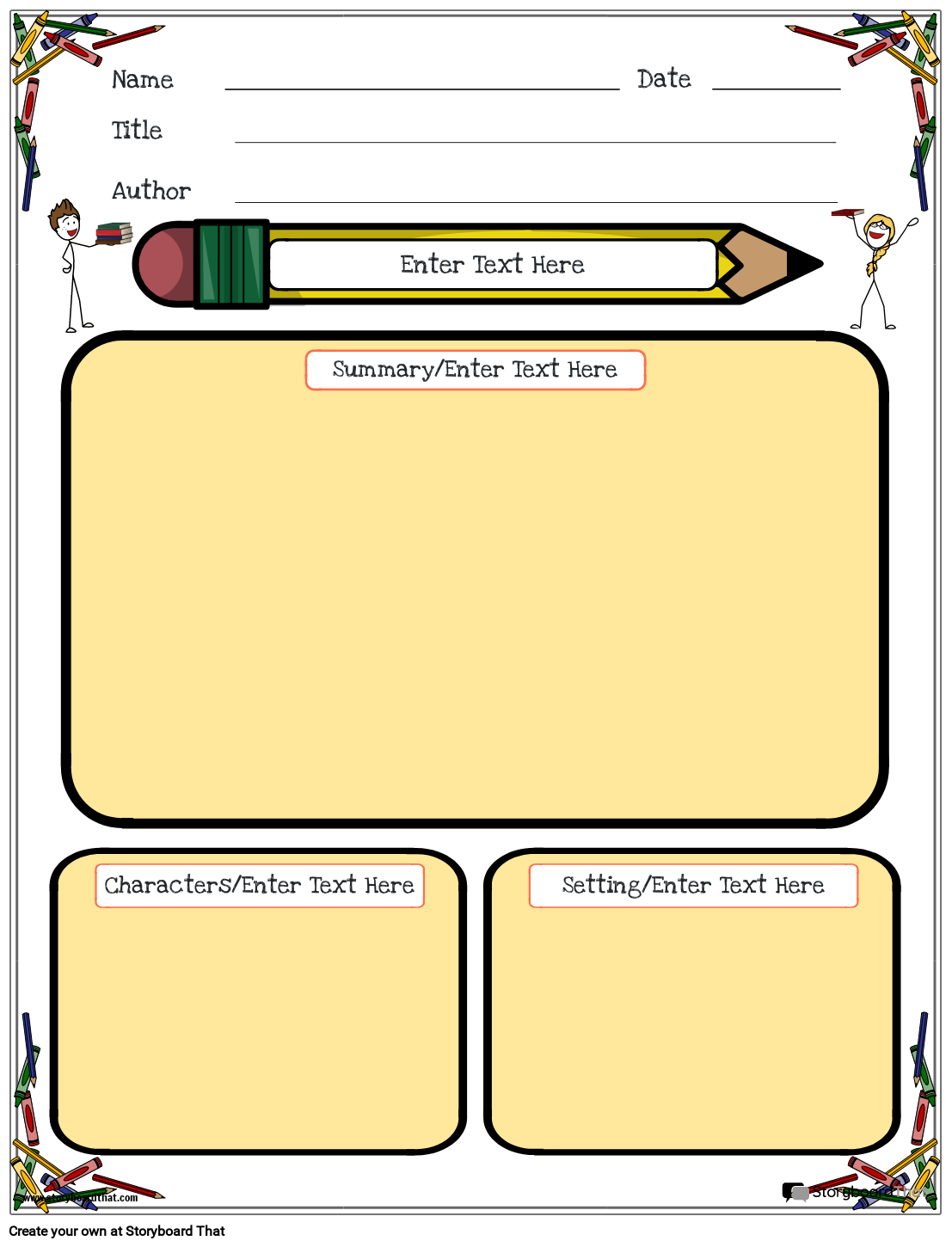
If you're assigning this to your students, copy the worksheet to your account and save. When creating an assignment, just select it as a template!

What is a Book Report?
It is a written summary and analysis of a book's content, intended to provide an overview of its key elements, themes, characters, and plot. It is often used as an educational tool to assess a reader's understanding of a book and their ability to critically analyze its various aspects. They can vary in structure and complexity depending on the grade level and educational objectives.
What are Book Report Planning Worksheets?
They are effective tools that teachers assign to students to organize ideas before beginning a larger, more in-depth report. This simple form is meant to highlight the main idea, plot, setting, and main characters of a book, while also showing that students understand what they read, and that they are able to present information about the pages they've read. Planning an outline ahead of time with a Storyboard That template is an essential step towards an incredible and unique project. This planning can be done in class or as homework in note form.
Why are they Important and How are they Best Used?
They are important because they help students create a plan before executing a large project. Students are able to take what they know from the book, and write it all down in one place. They are also able to decide what they want to include, or not include, in their reports by having all of the information laid out in front of them.
In the world of education, fostering reading comprehension and critical thinking skills is a vital mission. These worksheets provide a structured framework that guides the class through a journey of analyzing, understanding, and reflecting on the books they read.
Types of Projects
- The Traditional Report: The traditional approach involves key elements such as the title and author, summarizing the plot, character analysis, setting description, and personal opinions. These worksheets serve as book report forms that students can use to structure a specific idea, as well as their thoughts and insights. Kids are prompted to identify the main ideas, describe the book's aspects, and offer their opinions on their favorite parts.
- Character Analysis: Delving into characters is a fantastic way to enhance reading comprehension. Students can identify character traits, motivations, and changes throughout the story. By using a book report template for kids, teachers guide elementary-age children to critically think about the characters' development and role in the narrative.
- Setting Exploration: Settings often play a significant role in shaping the story's atmosphere and events. Our worksheets offer a structured platform for students to identify and describe the settings, as well as analyze how they impact the plot and characters. This free printable tool engages middle school students and elementary age kids in a deeper understanding of the story's context.
- Comparative Analysis: Comparing and contrasting two books with similar themes or genres is an enriching exercise. Students can analyze characters, plots, themes, and writing styles side by side. This activity encourages critical thinking as students identify similarities and differences between the two works, honing their ability to critically assess literature.
- Book-to-Movie Comparison: In an age where many books find themselves on the silver screen, comparing a book to its movie adaptation can be captivating. With our worksheets, students can highlight the differences and evaluate how successfully the adaptation captures the essence of the novel. This engaging activity invites children to express their opinion on how well the story transitioned from page to screen.
- Critical Book Review: Encouraging critical thinking is a cornerstone of education. Our handouts can be transformed into platforms for students to review what they've read with a discerning eye. By using a book report generator, students can evaluate plot development, character depth, and writing style, strengthening their analytical skills.
- Alternate Conclusion, Ending, or Sequel: Nurturing creativity is equally important. Our templates can serve as springboards for students to imagine alternate endings or sequels to the book. By completing a book report planning form, grade school children create new narrative possibilities, fostering their imaginative thinking.
- Letter to the Author: What better way to engage students than allowing them to interact with the author? Worksheets can include sections for students to write letters to authors, sharing their thoughts, questions, and reactions. This activity bridges the gap between the author's creation and the student's interpretation.
- Book Advertisement: These worksheets can take the form of designing advertisements or promotional posters for the book. By focusing on key aspects, students not only comprehend the book but also learn to present their understanding in a visually appealing manner.
- Timeline of Events: Understanding the chronological sequence of events is crucial in comprehending stories. Templates can be adapted to create timelines of important events from the book. Students fill in the report form with short summaries of events, identifying their significance, and arranging them chronologically.
Tips for Making a Template
- Understand the Purpose: Begin by understanding the purpose. It's a tool designed to guide students through the process of analyzing and summarizing a book's content.
- Identify Your Audience: Determine whether the worksheet is intended for elementary-grade students or middle-school students.
- Choose a Format: Decide on the format of your worksheet. You can use a no prep printable book report template, or create a custom design.
- Incorporate Structured Sections: Include sections for various aspects of the book such as a short summary, character analysis, and personal reflections.
- Utilize Free Resources: Search for free book report templates online to gather ideas and inspiration for your worksheet's layout and content.
- Consider Grade-Level Appropriate Language: Tailor the language used in the worksheet to suit the reading comprehension level of the students for whom it's intended.
- Add Visual Elements: Enhance engagement by incorporating visuals, like images or icons, to make the worksheet visually appealing.
- Provide Prompts for Analysis: Offer prompts and questions that encourage critical thinking. Include questions like "What is a book report?" and "What are some ideas to make your project unique?"
- Offer Space for Personalization: Include sections that allow students to share their personal opinions, a favorite part of the book, and creative insights.
- Include Organizational Tools: Utilize a book report maker or book report generator to create a professional-looking worksheet. A book report graphic organizer can also help students structure their thoughts effectively in their own words.
By incorporating elements like templates, book report planning forms for grade school, and relevant book report examples, you can design a worksheet that guides students through a comprehensive exploration of the book's content while fostering their creativity and critical thinking skills.
More Storyboard That Resources and Free Printables
- Creative Writing Worksheets
- Plot Diagram Template
- Student Planner Template
- Graphic Organizer Templates
How to Make a Book Report Worksheet
Choose one of the premade templates.
We have lots of templates to choose from. Take a look at our example for inspiration!
Click on “Copy Template”
Once you do this, you will be directed to the storyboard creator.
Give Your Worksheet a Name!
Be sure to call it something related to the topic so that you can easily find it in the future.
Edit Your Worksheet
This is where you will include directions, specific images, and make any aesthetic changes that you would like. The options are endless!
Click "Save and Exit"
When you are finished, click this button in the lower right hand corner to exit your storyboard.
From here you can print, download as a PDF, attach it to an assignment and use it digitally, and more!
Happy Creating!
Frequently Asked Questions About Book Reports
Do book report worksheets limit creativity.
No, they don't inherently limit creativity. While they provide structure through elements like book report templates, they can be adapted to encourage creative analysis. By exploring how to write a report that allows creativity, educators can strike a balance between structured analysis and imaginative insights. Ideas can be integrated to spark imaginative thinking. A well-designed book report template for kids allows room for personal expression while maintaining organization.
Do book reports differ based on grade levels?
Yes, they vary by grade level. Elementary reports focus on simple summaries and character descriptions. Middle school reports delve into themes and analysis. High school and college projects demand deeper analysis, including writing style and context. Worksheets and free book report templates can guide each level.
Are book reports limited to novels?
They extend beyond novels to include non-fiction, biographies, and more, and free book report templates adapt to different genres. A versatile book report template for kids accommodates various reading materials, and ideas cater to diverse literary forms.
Try 1 Month For
30 Day Money Back Guarantee New Customers Only Full Price After Introductory Offer
Learn more about our Department, School, and District packages

- Thousands of images
- Custom layouts, scenes, characters
- And so much more!!
Create a Storyboard
Book Report Packet for Middle School
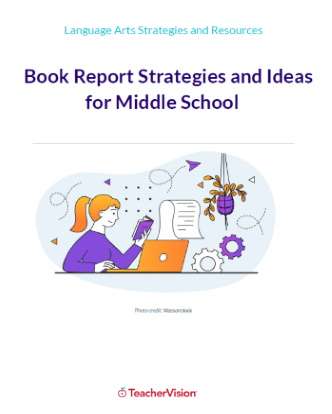
| Add to Folder | |
|---|---|
| creative writing | |
| children's book | |
| activities | |
| classroom tools | |
| language arts and writing | |
| vocabulary |
Tips and tools for how to write a book report
Use the 4 strategies and 2 resources in this packet to help your middle school students get more out of their reading and write better book reports. These strategies can be applied to any work of fiction, and the editable worksheets focus on collecting and organizing the most important plot and character information.
- 4 strategies with tips on how to put them into practice
- An editable plot sequencing printable for gathering and documenting important plot points
- An editable character study printable for summarizing character information by chapter
- A generic rubric for grading and assessing book study projects like book reports.
Some of the strategies featured include:
Create an alternate book cover, plot sequencing.

Featured Middle School Resources

Related Resources

About the author

Contributor
About stephanie.

- TemplateLab

Book Report Templates
30 book report templates & reading worksheets.
Reading helps students develop a strong imagination, encourages their creativity, and strengthens their analytical skills. Teachers assign a lot of book reports to ensure that students read lots of books, especially at that critical early age when they are still trying to master the written word. To cut down on some of the workload, students and teachers can find a book report template to download and fill in. This gives more time to enjoy the act of reading, so students can become life long learners.
Table of Contents
- 1 Book Report Templates
- 2.1 Why Provide A Book Report Form
- 2.2 Sections Of A Simple Book Report
- 2.3 Sections Of A Multi-Page Report
- 3 Sample Book Reports
- 4 Difference Between The Book Report Types
- 5.1 What To Do Once You’ve Written The Report
- 6 Book Report Examples
- 7 Tips for Teachers
- 8 Tips for Students
What Is A Book Report
A book report is typically given as an assignment to students in elementary and middle school. Students fill out a form answering basic questions about the book they were assigned to read. Turning in the report serves as proof to the teacher that the student read the book and, hopefully, got something out of it.
These reports may ask students to detail what the book was about, the names of the main characters, what the theme of the book is, and where the events are set. Some reports may ask specific questions about events or characters to ensure that the students read the book all the way through. The report can also help students understand the book better by asking them to think about its meaning and the plot.
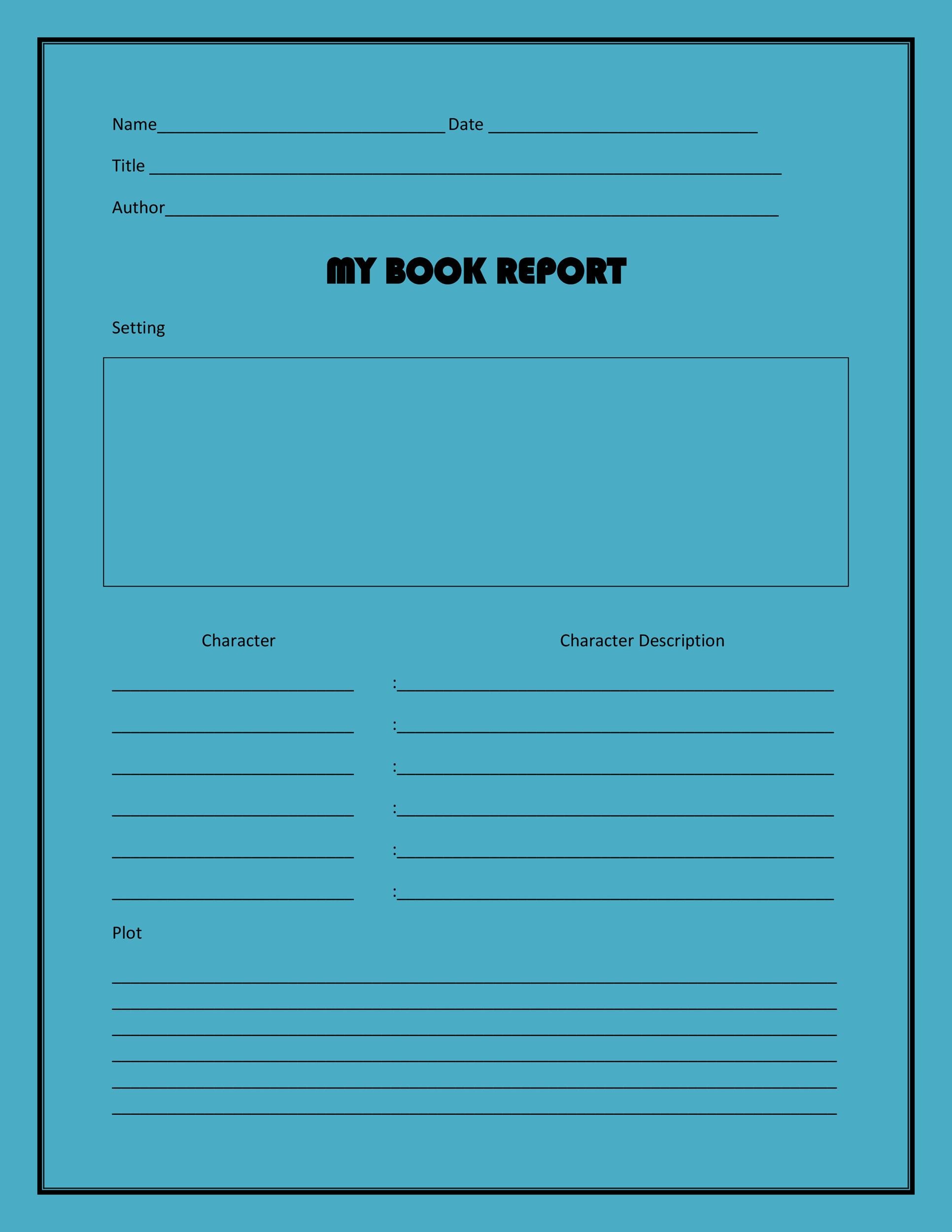
Reading Worksheets
Teachers may also hand out worksheets for students to complete in class or as homework. These are usually limited to the earlier grades when students are still learning to read. Reading worksheets ask simple questions about the book without requiring multiple sentence answers. These questions may ask students to name a favorite character, or mention the main conflict in a few words.
It’s not uncommon for the teacher to read a picture book with the class and have students fill out a worksheet afterwards. If the classroom has a bookshelf, there may also be a ‘Reading Time’ when students pick out a book to read. When they finish, the students fill out the worksheet and submit it to their teacher.
Why Provide A Book Report Form
Book report forms are a popular choice of assignment for elementary school classes. These forms make it simple for students to complete the report by filling out the worksheet. These sheets can be generic with standard questions, or teachers may create a unique sheet with questions specific to each different book that is assigned.
These forms also help introduce students to the idea of a book report format and show them what kind of information may be expected on longer, multi-page reports that they are expected to complete in the higher grades. A form is also easier to grade , especially for teachers who have a large classroom and more assignments to go over than usual.
Sections Of A Simple Book Report
A simple book report features a few sections that ask students to answer questions in paragraph format. These each ask students to detail a different element of the book. All book report forms will ask for the title, author name, and the illustrator’s name, if it is a picture book. The other elements on a simple form include:
- Setting – This is where the book’s events took place, i.e. New York.
- Characters – A list of who the main characters are and their names.
- Plot – A basic overview of the major events in the book.
- Your impressions – Whether you like the book or not, and why.
A simple form may also just ask the students to describe the beginning, middle, and end events of the book in three questions. Students may also be expected to identify the climax, which is the most intense point of the book where the main character’s problems are resolved or made worse. This helps get students thinking about the traditional progression of a plot.
Sections Of A Multi-Page Report
Eventually, teachers transition students to writing a multi-page book report. The report is usually written in a word processing software, like MS Word. Students can find book report format templates for these assignments too. These longer reports are written out in paragraph form. The teacher asks the students to address different elements of a book in their own words or with their own formatting. A simple way to organize these reports is to divide them into three basic sections, the introduction, main body, and conclusion. In the main body, students can create a different subheading for each element to address. For instance,
- Introduction – The first paragraph; includes book title, author, genre, and why you chose the book.
- Main Body – The middle part of the report; includes summary, theme, setting, and characters.
- Conclusion – A short summary of the book report and opinion of the book.
Sample Book Reports
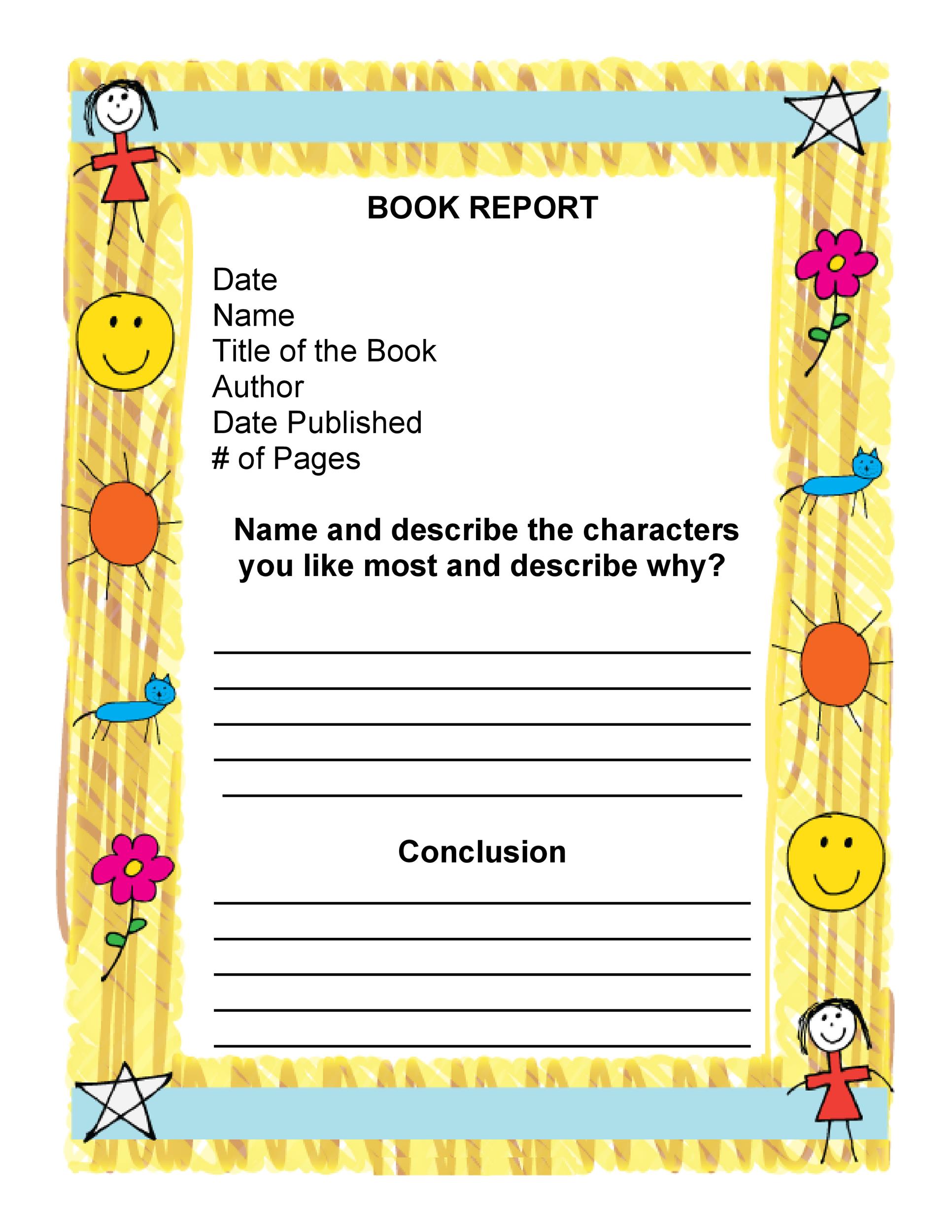
Difference Between The Book Report Types
The short book report form is handed out by the teacher and can be completed in one night like a homework assignment. A multi-page report is created by the student and may take more than one night to finish.
Short templates are available in lots of fun book report ideas suitable for young children. They have questions with a few lines to hand write the answers in a few short sentences. Some templates may include activities to make them more interesting to students, such as having them draw out a scene from the book or re-write the ending.
Multi-page reports start out as two page reports and gradually increase in size through middle school and high school. Of course, those two page reports are just as difficult for young students as the five page reports are for high school students . The great thing about these assignments is that students are usually free to organize their book report ideas however they desire. They can create bold sub-headers for the main body of the report. Students can write about the theme, characters, and setting separately. Or they can leave out the headers and devote their report to a specific element, such as the book theme. This allows students to weave information about characters and setting into the report where they are most relevant to the theme. The former works well for short chapter books, and the latter is better for books that may feature multiple themes.
Ideas for Different Kinds of Book Reports
There is more than one way to complete a book report. Both teachers and students may find these creative ideas more interesting than a straightforward report.
Write a review of the book. Create the report in the form of a newspaper or blog review. Summarize the book without giving away the plot or the ending. Talk about what made you like it or, if you hated it. Feel free to give the book a thumbs up or down rating at the end.
Do a diary. Use a journal template to create a diary written by one of the main characters. There should be multiple entries that follow or discuss the events of the book from that character’s point of view.
Interview one of the characters. Create an imaginary interview with one of the characters in the book. Ask them questions about where they come from, why the character did something important to the plot, and what the character thinks about the outcome of the events in the book.
Write a newspaper article. Create an imaginary newspaper article detailing one of the major events in the book, such as a theft or an important discovery. Make sure to answer the who, what, where, when, and why of these events in your article.
What To Do Once You’ve Written The Report
When students finish writing out their book reports, they have completed what is called the “First Draft” or “Rough Draft”. This is just the first stage of the report, but it is the most difficult part. Finishing up that report in the following steps is a lot easier.
Read and mark the report. Read through the book report from beginning to end to get a feel for it overall. Get a brightly colored pen to mark any spelling or punctuation errors you find in the report. Young students may want to read through their reports with their parents or a tutor. Sometimes, teachers actually make students submit a rough draft of their reports for points before the final report is due. The teacher reviews the draft, makes edits, and suggestions for changing the report before final submission.
Make edits to the report. Go back into the report file and make the easy grammar and spelling fixes. Take a look at your teacher’s suggestions or the ideas you wrote down for things to change in the report. Create a plan to make those additions or changes. Make the changes to the report. Don’t forget to save your file as a separate document. For instance, save your rough draft as, Report1.doc, and this updated version as, Report2.doc.
Review the report. Print out a fresh copy of the report. Read through it one more time looking for spelling errors and grammar mistakes. Keep an eye out for spots where the text doesn’t make sense. This can sometimes happen when you add new content to a report. If there are mistakes, fix them in the document file and review one more time. Your final draft is ready to print out when you can no longer find any mistakes.
Book Report Examples
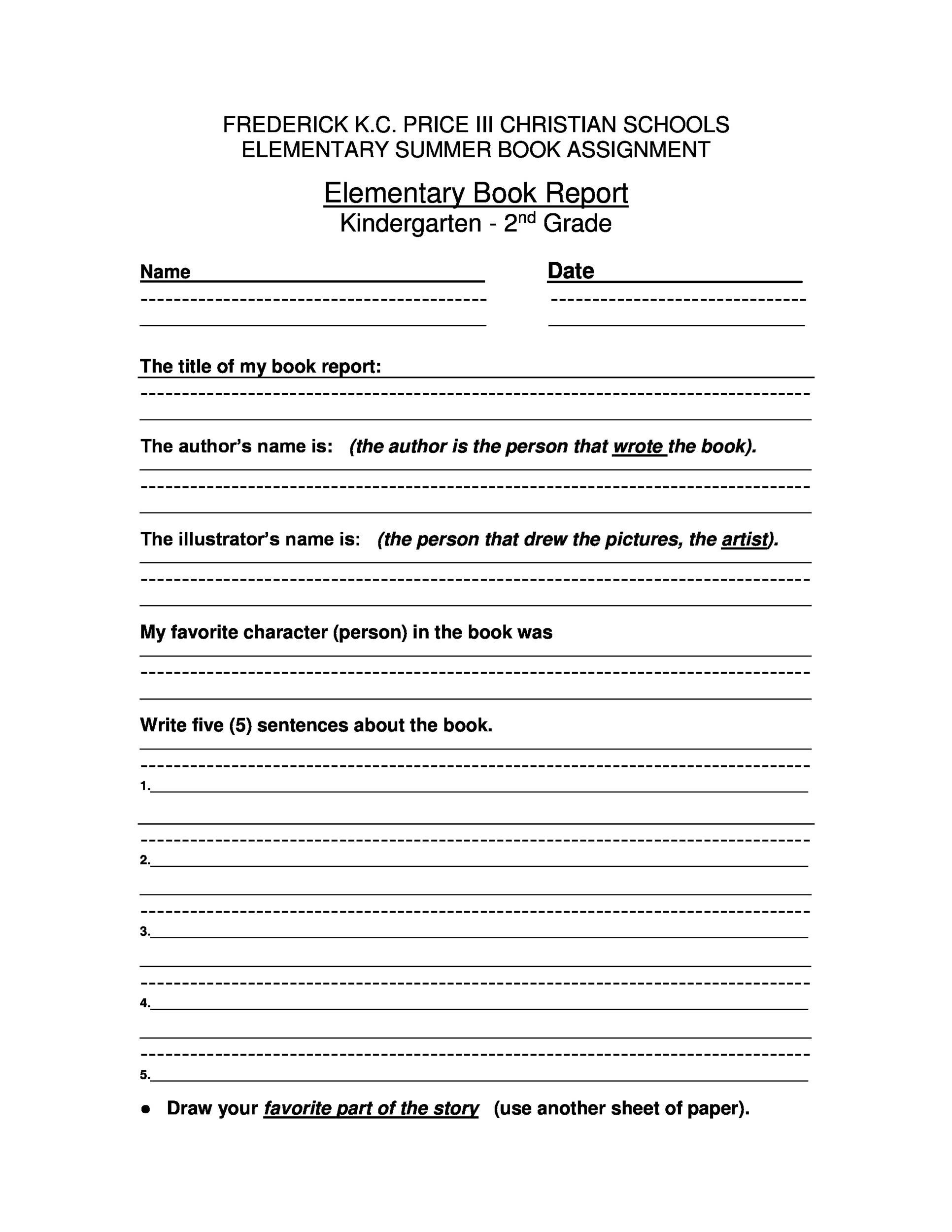
Tips for Teachers
Book reports are a big part of the curriculum. That doesn’t mean they have to be a lot of work for the students or the teacher. Make assigning these reports less of a hassle with these tips.
- Assign one book for the entire class to read. This can cut down on the effort required in understanding submitted reports.
- Pick out a short book report template to use. There is no need to use valuable time in creating one from scratch.
- Print out more copies of the form than are needed. Some students may lose theirs and need an extra form.
- Make reminder announcements when a due date approaches. Remind students at least twice before a book report due date.
- Keep the word count requirement low. Teachers also have to spend more time reviewing longer reports.
- Consider creative alternatives to some written reports. When your curriculum includes a lot of book reports, give students the option of turning in a drawing, diorama, or another project as a break.
Tips for Students
Being assigned a book report to complete can seem like a daunting task, especially if if you have never written a multi-page report. Make sure you don’t fall behind on the work by following a few of these tips.
- Make up a reading schedule to complete the book well in advance of the report being due. Use a calendar to remind yourself.
- Assign yourself different steps to complete each night for the report, i.e. make an outline, write 200 words, or revising
- Ask the teacher for help with ideas if you can’t figure out how to get started.
- Look for examples of completed reports to see how they are structured.
Book reports vary in their length and complexity. Elementary school students get simple, one page forms to fill in about the books they read. Those in middle school and high school usually have to write multiple page reports. Nearly all reports require students to talk about the plot, theme, characters, and how they liked the book. Both students and teachers can find a lot of templates to use. Those looking for something generic for students to fill in after reading a book can pick up a .pdf or .jpg form. Those who want more control over the look and wording of the template should download a .doc file.
More Templates
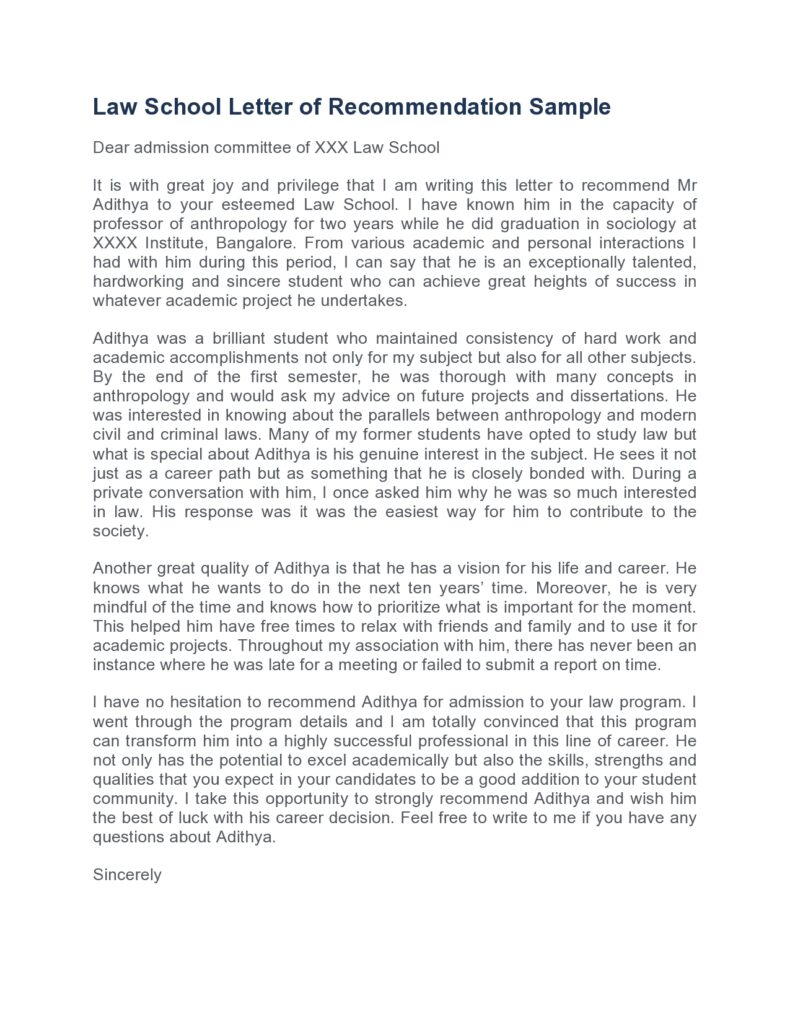
Law School Letters Of Recommendation
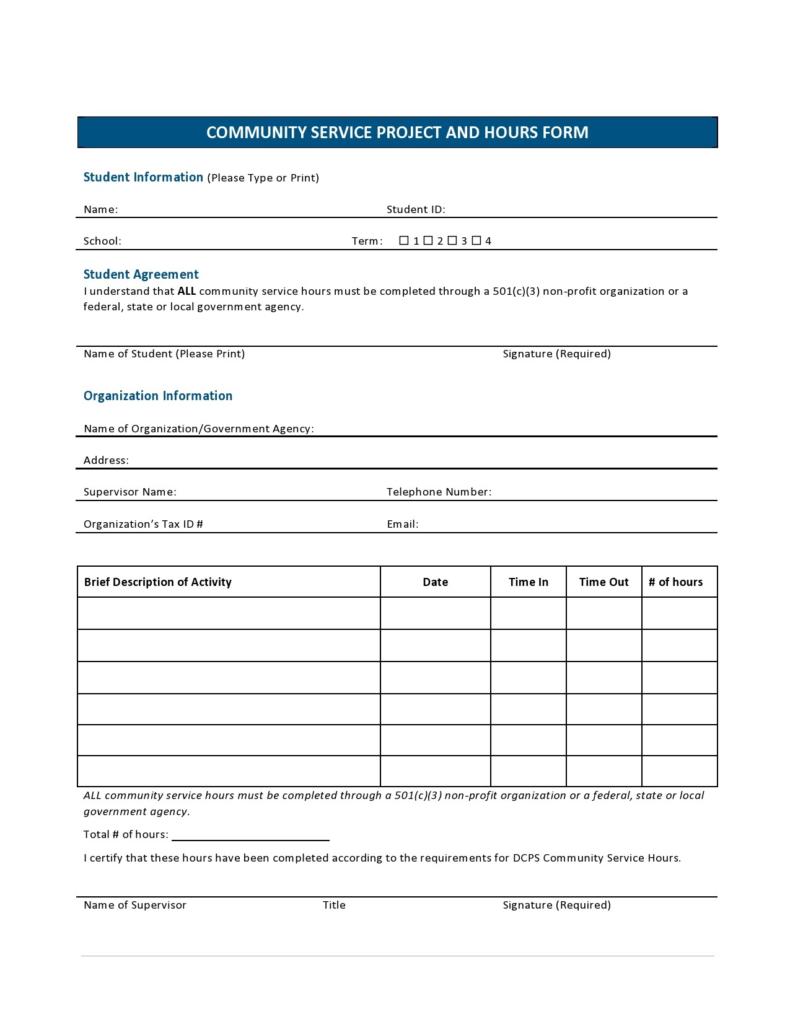
Community Service Forms
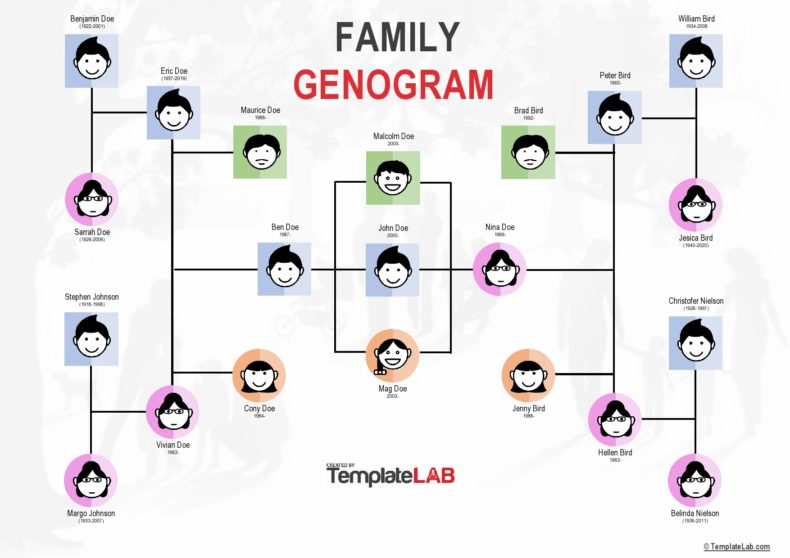
Genogram Templates
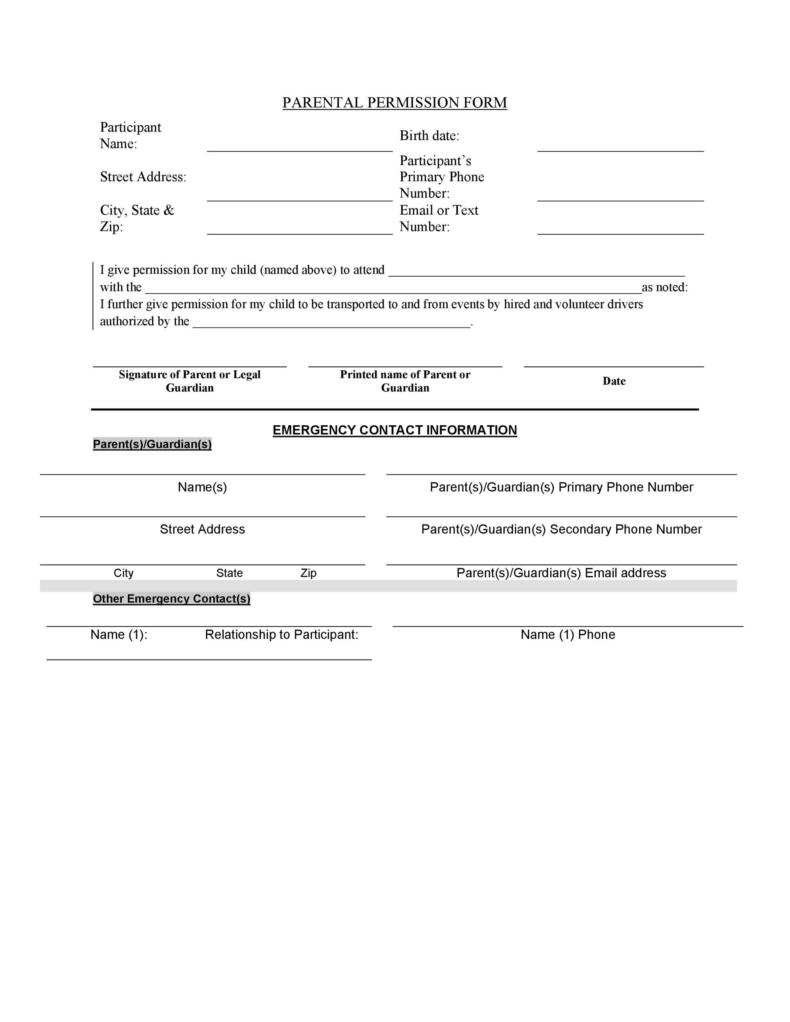
Permission Slip Templates
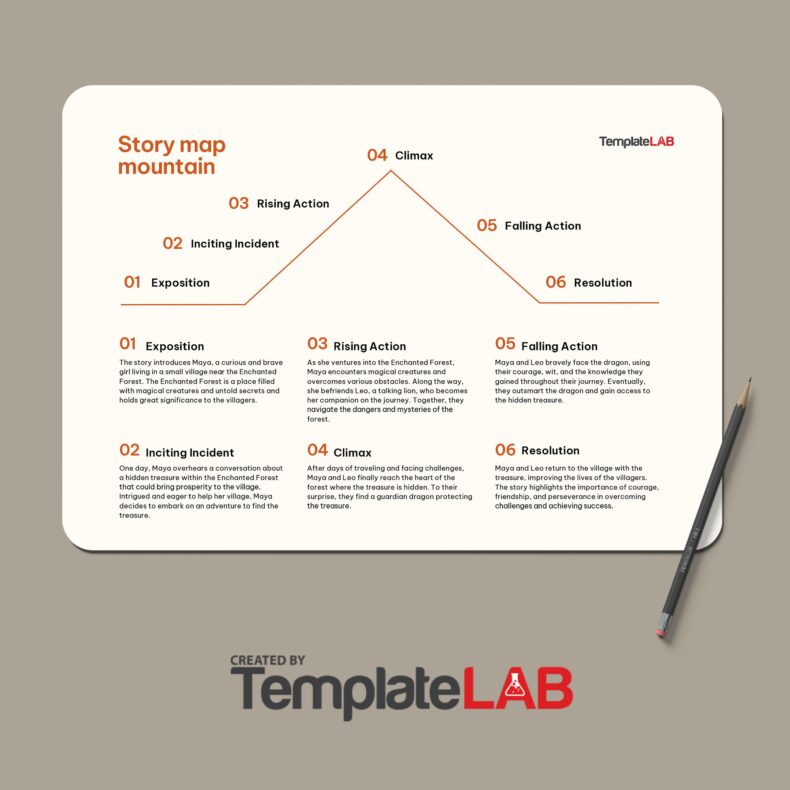
Story Map Templates

Essay Outline Templates
Verify originality of an essay
Get ideas for your paper
Find top study documents
Book Report Outline: Writing Steps, Key Elements, Templates
Updated 17 Apr 2024
Book report can be defined as an objective summary of key ideas or arguments contained in a book. This task is frequently assigned to elementary, middle school, high school, college students in the US. It’s aimed at fortifying or verifying their abilities to precisely summarize and convey large written works.
Hence, learning to do it right is not only important for scoring higher grades but also for mastering these essential associated skills. Some of these skills should do with reading and comprehending content, sketching detailed book report outline by extracting key points, main body, etc. Also, you need to detect plagiarism accurately with the plagiarism checker free of charge.
Chief purpose of book report is to make readers familiar with book’s content in brief and efficient manner (so that he/she can decide whether it is of any interest or use without having to read this book).

What Elements Should Outline Include?
Book report outline completed for fictional works usually contain following elements:
- Introduction made up of key bibliographical information – this is helpful in identifying written work you focus on, besides providing some useful contextual information.
- Book summary or plot – this summarizes content, characters, main event or plot twist.
- Description of main characters & most relevant/telling story elements/plot moments associated with them.
- Overall book message & purpose as intended by the author.
- Attitude towards or interpretation of book – this section allows to express your state, feelings, thoughts. impressions about this work. However, that unlike in reviews, where this is the most important and bulky section, in reports, this part is rather brief. To find out more about reviews proceed to our book review services .
Obviously, format of nonfiction book report outline would differ given that there are no characters or plots – in this case, it is ideas presented in each major section that is described along with other elements listed above.
Steps Involved in Writing a Report
Acing this kind of assignment implies mastering all related sub-tasks, like
- Reading, highlighting/making important notes. Balancing amount of highlighting is essential for it to be useful – you should limit it only to most important points and quotes to include them in outline. You might also be willing to mark quotes differently, to allow easy visual distinction from other highlighted sentences.
- Completing report outline by extracting main points from highlighted material, summarizing information, rearranging paragraphs to ensure smooth content flow. Page numbers might be included here to facilitate information retrieval in later. One could do this either on paper or on computing devices (even mobile phones), whichever is more convenient.
- Composing report itself using that outline for book report assembled earlier. Include quotes and numerous examples/details – these would prove to evaluators that you read text itself rather than its summary. Use quotes for greater effect but do not exaggerate with these. Also consult your instructions – various citation formats would require you to indicate page numbers from where quotes are taken.
- Editing/revising/proofreading of outline – to eliminate mistakes, confusing formulations, unclarities, etc. If you’ve got ready essays/reports/papers you want to edit/proofread, use our online essay editor that includes grammar, spelling, task requirement check.
Read also: Paraphrase Citation : How to Not Make a Mistake
How to Write Report for Students of Different Level
Students at various educational levels have various abilities, which suggests that assigned tasks should be adapted correspondingly:
- How to write a book report for the 4th grade – at this young age, students should be presented with straightforward strategies, ideally practiced outside this project, such as evaluating good or bad sides of characters, summarizing plots, creating report outline samples, expressing personal opinions. Illustration and practice on minor tasks are key before proceeding to bigger projects.
- How to write a book report for the 5th grade – 5th graders are somewhat more advanced in their competences. If they had at least one report assignment in previous grades, they should approach more complex projects.
- How to write a book report for the 6th grade – most elementary schools in US continue up to grade 6, hence, this is when students in primary education possess most evolved abilities, which translates in even more complex projects they can undertake (in particular, more complex readings). Also, these students are much better at individual work than younger ones.
- How to write a book report for college level – obviously, in this case, there is a qualitative leap in comprehension, thinking, ability to summarize, and synthesize information that simply outshines those of elementary, middle, or high school students. College students can approach complicated projects based solely on provided instructions without much clarification, they can self-organize and find the best strategies to accomplish corresponding sub-tasks, like completing book report outline, character description, etc. Finally, they can explore very complex or even professionally-related literature.
Read also: How to Format Dialogue Correctly (for books, essays, stories)
Need more writing assistance?
Connect with our top writers and receive a book report crafted to your needs. Our research proposal writing services can help you make your research proposal stand out from the crowd.
College Book Report Template
The college book report template provided below gives good sense of what content should be included in report, how outline should be completed. You can use this outline as a structure for your own report, or just read it for inspiration before completing your essay:
1. Introduction. Here, bibliography elements should be listed (author's name, genre, publication date, publisher number of pages, etc.), main idea of the story (along with occasional lines for capturing reader’s attention).
Example: “The book “The Big Sleep” authored by Raymond Chandler and published in 1988 (Vintage Crime/Black Lizard) belongs to the detective genre. It focuses on degrading morals of many representatives in society, as a side effect of capitalism/consumer culture.”
2. Summary. Here, one should list: setting, atmosphere, time of events, general plot (very brief), narrating perspective, but also main theme/argument.
“The narrative is set during the Depression, in the 1930’s in Los Angeles and Hollywood – at that time, a dark, rain-soaked, depraved, dangerous city jungle (an atmosphere portrayed in detail). Detective Philip Marlowe comes in contact with wealthy Sternwood family as part of his job. Here, he comes to know the Sternwood sisters and becomes involved in a series of events, which he investigates, revealing dark secrets they hide.”
3. Characters. One should outline here main characters as well as their pursuits/conflicts. Note that this section is only valid for fiction books.
The central characters are detective Philip Marlowe (the protagonist from whose perspective narration happens) and the Sternwood sisters: Vivian and Carmen. Marlowe is a fairly young gentleman, formal and polite, with high moral standards – he is a positive character (a moral gauge), always in his quest for truth. Vivian is the elder sister, very careful with her looks but with a rather vicious lifestyle (she becomes somewhat acquainted with Marlowe) and who is protective of Carmen. As for Carmen, she is an ill-mannered, ill-tempered, possessive, vengeful young lady – a truly negative character.
4. Plot. This section should contain the overall story, listing only major plot twists, conflict resolution, ending. Note that this section only applies to fiction books.
Example: As the head of the Sternwood family invites Marlowe to find out more about a disappeared relative, he finds out more about this family getting to interact with both Vivian and Carmen. After a series of adventures, Marlowe discovers that it is Carmen who killed missing relative (for refusing her romantically), while Vivian covered up the crime. Carmen even tries to shoot Marlowe, but Marlowe anticipates this and takes appropriate action.
5. Evaluation with Conclusion. The last part of report outline. Mention here whether you found reading interesting or not and why, what you felt and learned from it, what its strong/weak aspects are, etc. Note that this part should be rather brief, unlike in reviews, where analysis rather than summarizing is key.
Read also: Ask " write my lab report for me "!
Instant Outline Help
As one can infer from above, writing reports are fairly time-consuming reading book itself takes longest and even challenging. If you are out of time for any reason, our professional team of writers at Edubirdie can pick up your task and submit high-quality outline.
Importantly, with our service, you can request intermediary results, such as book report outline or draft, to assess whether projects are heading in the right direction, you can also guide writers by providing feedback. You are free to select your preferred expert according to ratings and in case final results do not match instructions or desired quality, you are guaranteed to benefit from unlimited free revisions. With such low risks and guaranteed outcome, it would be pity not to give it a try.
Was this helpful?
Thanks for your feedback, related blog posts, how to overcome writer’s block.
Our article will help you learn how to overcome writer's block with the best practical methods. You will learn the symptoms that define it and rece...
PESTLE analysis example: explanation & tips
Understanding the larger environment in which a company operates is vital for planning and making decisions. One of the most effective tools for th...
How to Write a College Paper Successfully
Writing a college paper is an undeniably challenging task. It is one of those chances you are expected to show your professors the kind of student ...
Join our 150K of happy users
- Get original papers written according to your instructions
- Save time for what matters most
Published in
Book Templates
22 Printable Book Report Templates (Worksheets) – Word | PDF
Writing a book report is something that many of us have been tasked with before, particularly as students. A book review works as a succinct summary of the story of a book, and its characters, its plot, its core themes, message, and much more, and is a convenient yet effective way in which readers may convey what they took away from a particular piece of literature. Additionally, it allows readers to be critical of the works they read, giving it an added degree of depth and importance.
Writing a book report is an important part of academia, and also has a ton of application within the professional world. For these reasons, we’re going to take you through a comprehensive guide with which you can easily write a book report on just about any literary work.
What is a Book Report?
As the name suggests, a book report is pretty much that – a report on the experience a reader had with a particular piece of literature. Most often, a book report contains basic details on the book and author – information on the author’s upbringing, inspiration, education, and professional background are all very relevant to a book report. Generally, a solid and comprehensive book report contains the following elements:
- A succinct and brief summary of the plot or the core philosophies that are outlined in the book.
- A personal, individual analysis of the various themes and topics covered in the book.
- A personal and deep analysis of the numerous characters and/or personalities explored in the book.
- Background information that went into the publication of the book, such as information about the author, historical context, political movements, and the like.
- A final statement on why the writer of the report found the book interesting or uninteresting, complete with critical viewpoints backed up by excerpts from the book.
These elements are necessary for writing a comprehensive book report. In the next section, we’ll guide you through the process of writing the book report.
How Do I Write a Book Report?
Before you get started on the book report itself, it is a good idea to compile all your thoughts on the book into a brief set of notes that you can easily refer to. Additionally, you can list any ideas and/or critical viewpoints you may have, allowing you to easily reference different sections of the book in the report.
Once you have your summary and your notes on hand, you can get started with writing the book report. Follow these tips and format in the specified order to write an effective book report;
- Introduction – The introductory paragraph should declare the name of the author, date and year of publication, publisher, country of publication, and any other relevant historical information. Typically, this includes a small background on the author, the historical context of the time it was written, and the situation of the country in which the book was written. Once that’s done, you’re ready to move onto the next section.
- Next, you should present an overarching summary of the book. For fictional works, this means that you should write down an in-depth synopsis of the story, whereas non-fiction works generally merit a break down of the theories, philosophies, accounts, and general themes explored in the book.
- The next section accounts for the report writer’s personal opinions and experience with the book – In this section, you should outline what you thought about the book and why. Then why is particularly important in writing an effective book report – Your opinions, claims, criticism, and praises should all be backed by references taken from the book, such as excerpts or quotations. Tie this into the historical background of the author and the work itself to write an even more effective book report.
- Bibliography – While this may not particularly hold true for all fiction works, it is very common when dealing with non-fiction works. Often, multiple sources are cited in non-fiction works, which may encourage the reader to do some literary exploration and delve into other authors. When this happens, some of these discoveries are bound to tie into the book review. When these sources are used, make sure to cite them categorically and add a bibliography page.
These are the steps you need to follow to write an effective book review. Once you’ve finished writing it, make sure to do a thorough proofread, while also checking for logical follow from start to finish.

Book Report Templates & Examples
Following are free downloadable book report templates and examples that can be downloaded for free:
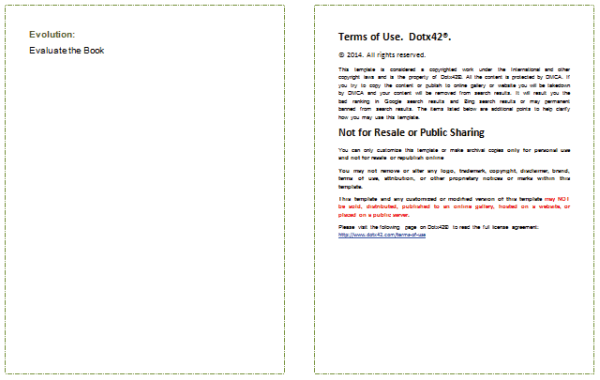
Frequently Asked Questions
What is the format of a book report.
Typically, a book report is formatted academically. This includes an introduction, a summary of the work itself, the author of the report’s opinions, findings, criticisms, and praises, and finally, a review and summary of the author’s arguments. It is typically formatted with a 1 or 2-pt margin, with double-spaced fonts like Times New Roman or Arial.
How do you write a book report?
A book report is a comprehensive summary of both the book itself, as well as the reader’s thoughts, opinions, and experience reading the book. As a result, it should contain information on the book itself, including the background of the author, a summary of the key aspects of the book, and well-reasoned, logically sound arguments made by the writer of the report. Check out our guide to find a step-by-step guide to writing a book report.
How many pages should a book report be?
Most commonly, a book report falls between 800-1,000 words. If the font is Times New Roman, 1-pt margins, and double-spaced, which is the academic standard, this comes up to a page count of 3-4 pages.
Keep reading
32 free editable address book templates, 25+ free checkbook register templates (excel, word), 20+ free recipes cookbook templates (word, psd, ai, pdf), free phone book templates (word | excel), 20 free guest book templates (word | excel | pdf).
Book Report Template

- Word Document File
Description
Book Report Template for Middle school (-ish) age students.
Encourages descriptions for Main characters, Plot summary, Opinions. Five star rating fill in at the bottom.
Questions & Answers
Brittany bonner.
- We're hiring
- Help & FAQ
- Privacy policy
- Student privacy
- Terms of service
- Tell us what you think
- Grades 6-12
- School Leaders
Check Out Our 32 Fave Amazon Picks! 📦
42 Creative Book Report Ideas for Students
Inspire your students to share their love of books.

Responding to what you read is an important literacy skill. Reading about other people’s experiences and perspectives helps kids learn about the world. And although students don’t need to dive deeply into every single book they read, occasionally digging into characters, settings, and themes can help them learn to look beyond the prose. Here are 42 creative book report ideas designed to make reading more meaningful.
1. Concrete Found Poem

This clever activity is basically a shape poem made up of words, phrases, and whole sentences found in the books students read. The words come together to create an image that represents something from the story.
2. Graphic Novel
Have students rewrite the book they are reading, or a chapter of their book, as a graphic novel. Set parameters for the assignment such as including six scenes from the story, three characters, details about the setting, etc. And, of course, include detailed illustrations to accompany the story.
3. Book Snaps

Book Snaps are a way for students to visually show how they are reacting to, processing, and/or connecting with a text. First, students snap a picture of a page in the book they are reading. Then, they add comments, images, highlights, and more.
4. Diary Entry
Have your students place themselves in the shoes of one of the characters from their book and write a first-person diary entry of a critical moment from the story. Ask them to choose a moment in the story where the character has plenty of interaction and emotion to share in a diary entry.
5. Character To-Do List

This fun activity is an off-the-beaten-path way to dive deep into character analysis. Get inside the head of the main character in a book and write a to-do list that they might write. Use actual information from the text, but also make inferences into what that character may wish to accomplish.
6. Mint Tin Book Report

There are so many super-creative, open-ended projects you can use mint tins for. This teacher blogger describes the process of creating book reports using them. There’s even a free template for cards that fit inside.
7. Fictional Yearbook Entries
Ask your students to create a yearbook based on the characters and setting in the book. What do they look like? Cut out magazine pictures to give a good visual image for their school picture. What kind of superlative might they get? Best looking? Class clown? What clubs would they be in or lead? Did they win any awards? It should be obvious from their small yearbooks whether your students dug deep into the characters in their books. They may also learn that who we are as individuals is reflected in what we choose to do with our lives.
8. Book Report Cake

This project would be perfect for a book tasting in your classroom! Each student presents their book report in the shape of food. See the sandwich and pizza options above and check out this blog for more delicious ideas.
9. Current Events Comparison
Have students locate three to five current events articles a character in their book might be interested in. After they’ve found the articles, have them explain why the character would find them interesting and how they relate to the book. Learning about how current events affect time, place, and people is critical to helping develop opinions about what we read and experience in life.
10. Sandwich Book Report

Yum! You’ll notice a lot of our creative book report ideas revolve around food. In this oldie but goodie, each layer of this book report sandwich covers a different element of the book—characters, setting, conflict, etc. A fun adaptation of this project is the book report cheeseburger.
11. Book Alphabet
Choose 15 to 20 alphabet books to help give your students examples of how they work around themes. Then ask your students to create their own Book Alphabet based on the book they read. What artifacts, vocabulary words, and names reflect the important parts of the book? After they find a word to represent each letter, have them write one sentence that explains where the word fits in.
12. Peekaboo Book Report

Using cardboard lap books (or small science report boards), students include details about their book’s main characters, plot, setting, conflict, resolution, etc. Then they draw a head and arms on card stock and attach them to the board from behind to make it look like the main character is peeking over the report.
13. T-Shirt Book Report

Another fun and creative idea: Create a wearable book report with a plain white tee. Come up with your own using Sharpie pens and acrylic paint. Get step-by-step directions .
14. Book Jacket
Have students create a new book jacket for their story. Include an attractive illustrated cover, a summary, a short biography of the author, and a few reviews from readers.
15. Watercolor Rainbow Book Report
This is great for biography research projects. Students cut out a photocopied image of their subject and glue it in the middle. Then, they draw lines from the image to the edges of the paper, like rays of sunshine, and fill in each section with information about the person. As a book report template, the center image could be a copy of the book cover, and each section expands on key information such as character names, theme(s), conflict, resolution, etc.
16. Act the Part
Have students dress up as their favorite character from the book and present an oral book report. If their favorite character is not the main character, retell the story from their point of view.
17. Pizza Box Book Report

If you’re looking for creative book report ideas that use upcycled materials, try this one using a pizza box. It works well for both nonfiction and fiction book reports. The top lid provides a picture of the book cover. Each wedge of the pizza pie tells part of the story.
18. Bookmark
Have students create a custom illustrated bookmark that includes drawings and words from either their favorite chapter or the entire book.
19. Book Reports in a Bag

Looking for book report ideas that really encourage creative thinking? With book reports in a bag, students read a book and write a summary. Then, they decorate a paper grocery bag with a scene from the book, place five items that represent something from the book inside the bag, and present the bag to the class.
20. Reading Lists for Characters
Ask your students to think about a character in their book. What kinds of books might that character like to read? Take them to the library to choose five books the character might have on their to-be-read list. Have them list the books and explain what each book might mean to the character. Post the to-be-read lists for others to see and choose from—there’s nothing like trying out a book character’s style when developing your own identity.
21. File Folder Book Report

Also called a lap book, this easy-to-make book report hits on all the major elements of a book study and gives students a chance to show what they know in a colorful way.
22. Collage
Create a collage using pictures and words that represent different parts of the book. Use old magazines or print pictures from the Internet.
23. Book Report Triorama

Who doesn’t love a multidimensional book report? This image shows a 3D model, but Elisha Ann provides a lesson to show students how to glue four triangles together to make a 4D model.
24. Timeline
Have students create a timeline of the main events from their book. Be sure to include character names and details for each event. Use 8 x 11 sheets of paper taped together or a long portion of bulletin board paper.
25. Clothes Hanger Book Report Mobile

This creative project doesn’t require a fancy or expensive supply list. Students just need an ordinary clothes hanger, strings, and paper. The body of the hanger is used to identify the book, and the cards on the strings dangling below are filled with key elements of the book, like characters, setting, and a summary.
26. Public Service Announcement
If a student has read a book about a cause that affects people, animals, or the environment, teach them about public service announcements . Once they understand what a PSA is, have them research the issue or cause that stood out in the book. Then give them a template for a storyboard so they can create their own PSA. Some students might want to take it a step further and create a video based on their storyboard. Consider sharing their storyboard or video with an organization that supports the cause or issue.
27. Dodecahedron Book Report

Creative book report ideas think outside the box. In this case, it’s a ball! SO much information can be covered on the 12 panels , and it allows students to take a deep dive in a creative way.
28. Character Cards
Make trading cards (like baseball cards) for a few characters from the book. On the front side, draw the character. On the back side, make a list of their character traits and include a quote or two.
29. Book Report Booklets

This clever book report is made from ordinary paper bags. Stack the paper bags on top of each other, fold them in half, and staple the closed-off ends of the bags together. Students can write, draw, and decorate on the paper bag pages. They can also record information on writing or drawing paper and glue the paper onto the pages. The open ends of the bags can be used as pockets to insert photos, cut-outs, postcards, or other flat items that help them tell their story.
30. Letter to the Author
Write a letter to the author of the book. Tell them three things you really liked about the story. Ask three questions about the plot, characters, or anything else you’re curious about.
31. Book Report Charm Bracelet

What a “charming” way to write a book report! Each illustrated bracelet charm captures a character, an event in the plot, setting, or other detail.
32. Fact Sheet
Have students create a list of 10 facts that they learned from reading the book. Have them write the facts in complete sentences, and be sure that each fact is something that they didn’t know before they read the book.
33. Cereal Box TV Book Report

This book report project is a low-tech version of a television made from a cereal box and two paper towel rolls. Students create the viewing screen cut-out at the top, then insert a scroll of paper with writing and illustrations inside the box. When the cardboard roll is rotated, the story unfolds.
34. Be a Character Therapist
Therapists work to uncover their clients’ fears based on their words and actions. When we read books, we must learn to use a character’s actions and dialogue to infer their fears. Many plots revolve around a character’s fear and the work it takes to overcome that fear. Ask students to identify a character’s fear and find 8 to 10 scenes that prove this fear exists. Then have them write about ways the character overcame the fear (or didn’t) in the story. What might the character have done differently?
35. Mind Maps
Mind maps can be a great way to synthesize what students have learned from reading a book. Plus, there are so many ways to approach them. Begin by writing a central idea in the middle of the page. For example, general information, characters, plot, etc. Then branch out from the center with ideas, thoughts, and connections to material from the book.
36. Foldables

From Rainbows Within Reach , this clever idea would be a great introduction to writing book reports. Adapt the flap categories for students at different levels. Adjust the number of categories (or flaps) per the needs of your students.
37. Board games
This is a great project if you want your students to develop a little more insight into what they’re reading. Have them think about the elements of their favorite board games and how they can be adapted to fit this assignment. For more, here are step-by-step directions .
38. Comic strips

If you’re looking for creative book report ideas for students who like graphic novels, try comic strips. Include an illustrated cover with the title and author. The pages of the book should retell the story using dialogue and descriptions of the setting and characters. Of course, no comic book would be complete without copious illustrations and thought bubbles.
39. Timeline
Create a timeline using a long roll of butcher paper, a poster board, or index cards taped together. For each event on the timeline, write a brief description of what happens. Add pictures, clip art, word art, and symbols to make the timeline more lively and colorful.
40. Cereal Box
Recycle a cereal box and create a book report Wheaties-style. Decorate all sides of the box with information about the book’s characters, setting, plot, summary, etc.
41. Wanted Poster

Make a “wanted” poster for one of the book’s main characters. Indicate whether they are wanted dead or alive. Include a picture of the character and a description of what the character is “wanted” for, three examples of the character showing this trait, and a detailed account of where the character was last seen.
42. Movie Version
If the book your students have read has been made into a movie, have them write a report about how the versions are alike and different. If the book has not been made into a movie, have them write a report telling how they would make it into a movie, using specific details from the book.
What creative book report ideas did we miss? Come share in our We Are Teachers HELPLINE group on Facebook.
Plus, check out the most popular kids’ books in every grade..

You Might Also Like

Expand Your Readers’ Palates With a Book Tasting
A perfect way for kids to nibble on a book. Continue Reading
Copyright © 2024. All rights reserved. 5335 Gate Parkway, Jacksonville, FL 32256
- Outline Template
- Book Outline Template
Middle School Outline Template For Book Report
ADVERTISEMENT

Related Articles
Related forms.

Related Categories
- Character Sheet
- Book Jacket Book Report Template
- Plot Outline Template
- Persuasive Speech Outline Template
- Essay Outline Template
- Research Paper Outline
- Story Outline Template
- Speech Outline Template
- Syllabus Outline Template
Please, turn your attention
By pressing 'print' button you will print only current page. To print the document completely, please, download it.
Summary Outline For Middle School
Summer outline for middle school.
Student : [YOUR NAME] Subject : [SUBJECT NAME] Topic : [TOPIC NAME] Date : [DATE] Teacher : [TEACHER'S NAME]
I. Introduction
This template assists middle school students in effectively summarizing and organizing information on [TOPIC NAME] . It is tailored to foster a deeper understanding and structured recall of classroom discussions, lectures, or reading assignments.
II. Main Points
1. topic overview:.
What is the topic? [BRIEF DESCRIPTION OF THE TOPIC]
Why is it important? Discuss its importance to enhance understanding of its impact or relevance in everyday life.
2. Definitions:
Key Terms: List and define crucial terms associated with the topic.
Examples: Provide clear examples to show how these terms are used in context.
III. Detailed Content
1. subtopic one:.
Description : [DETAILED DESCRIPTION OF SUBTOPIC ONE]
Key Points: Identify and explain the main ideas or themes within this subtopic.
Examples/Case Studies: Use specific examples or brief case studies to solidify understanding.
2. Subtopic Two:
Description : [DETAILED DESCRIPTION OF SUBTOPIC TWO]
Key Points: Discuss significant points or theories covered.
Examples/Case Studies: Apply practical examples to enhance comprehension.
3. Subtopic Three:
Description : [DETAILED DESCRIPTION OF SUBTOPIC THREE]
Key Points: Outline and elaborate on essential concepts or arguments.
Examples/Case Studies: Illustrate with relatable examples for better engagement.
IV. Connections to Other Subjects
Interdisciplinary Links: Explore how [TOPIC NAME] integrates with other subjects.
Mathematics: Discuss any mathematical concepts that relate to the topic.
Science: Explain scientific principles that underpin or are related to the topic.
History: Connect historical events or figures that may have influenced or resulted from the topic.
V. Visual Aids
Charts and Graphs: Include any charts or graphs that help visualize data or concepts from the topic.
Diagrams: Use diagrams to illustrate complex processes or relationships.
Images: Add relevant images to provide visual context or enhance understanding.
VI. Critical Thinking Questions
Question 1 : [THOUGHT-PROVOKING QUESTION RELATED TO THE TOPIC]
Question 2 : [ANOTHER RELEVANT QUESTION]
Purpose of Questions: These are designed to encourage deeper inquiry and critical analysis of the topic.
VII. Practical Applications
Real-World Application: How can the knowledge gained from this topic be applied in everyday life or observed in the world around us?
Future Implications: Consider potential future developments related to the topic and their possible impacts.
VIII. Summary and Conclusion
Key Takeaways: Recap the most important points from the summary.
Personal Insights: Reflect on what was learned and how it changed your perspective on the topic.
Suggestions for Further Study: Identify areas where additional information or research could expand understanding or offer new insights.
Summary Templates @ Template.net

IMAGES
VIDEO
COMMENTS
When you go to write your book report, be sure to include the information completed on the following pages. The final report must be typed and double spaced. Be sure to hand into your Reading teacher both this template and the book report when you return to school. Introductory paragraph - What is the name and author of the book on which you ...
Meeting educational standards. Our book report templates are designed to meet common core standards for English language arts. They provide a structured way for students to engage with the text, ensuring they meet grade-level expectations for comprehension and writing. These templates are suitable for various grade levels, from upper elementary ...
A book report is a typical assignment for students throughout their school years, whether in elementary, middle, or high school. The report serves as a method to show that the students have read the book adequately and in its entirety. ... How to Outline a Book Report Template. The outline is the frame of the report you will write down your ...
"Middle School Outline Template for Book Report" (Trinity Catholic School) This PDF outline template breaks the book report down into manageable sections for seventh and eighth graders by asking for specific information in each paragraph. "Forms for Writing a Book Report for High School" In this ...
This story elements book report template for 7th-grade students includes five rows, with each row containing a story element (characters, setting, problem, solution, and theme). For each row, students will record written information in the enclosed space, and sketch a drawing in the open space. Download template. 2.
The TeacherVision editorial team is comprised of teachers, experts, and content professionals dedicated to bringing you the most accurate and relevant information in the teaching space. View TeacherVision's profile. Assigning a book report? Print and share this set of book report elements, outlines, and examples with your students.
Easily create a comprehensive outline for a middle school book report using our free template. Fill out the outlines online, customize it to your requirements, and save it as a PDF or Word document for printing or digital sharing.
2. Identify the main elements of the book. Scrutinize the book's primary components, including its main themes, characters, setting, and plot. These elements will form the basis of your report. 3. Formulate a thesis statement. Compose a thesis statement that encapsulates your personal perspective about the book.
Planning an outline ahead of time with a Storyboard That template is an essential step towards an incredible and unique project. ... This free printable tool engages middle school students and elementary age kids in a deeper understanding of the story's context. ... to include non-fiction, biographies, and more, and free book report templates ...
Included in this resource are: 4 strategies with tips on how to put them into practice. An editable plot sequencing printable for gathering and documenting important plot points. An editable character study printable for summarizing character information by chapter. A generic rubric for grading and assessing book study projects like book reports.
Middle School Book Report Page 1. Interesting Character. Pick the character you think is the most interesting. What attributes (characteristics) does this character possess that make that character especially interesting to you? Name at least three traits and give specific examples from the story of the character displaying each trait.
There is more than one way to complete a book report. Both teachers and students may find these creative ideas more interesting than a straightforward report. Write a review of the book. Create the report in the form of a newspaper or blog review. Summarize the book without giving away the plot or the ending.
middle school outline template for book report - Free download as PDF File (.pdf), Text File (.txt) or read online for free. This template provides a structure for writing a book report in 6 paragraphs. The introductory paragraph should include the book title, author, and 3 facts about the author. The second paragraph gives a brief summary and describes the setting.
Book Report Outline: Writing Steps, Key Elements, Templates. Book report can be defined as an objective summary of key ideas or arguments contained in a book. This task is frequently assigned to elementary, middle school, high school, college students in the US. It's aimed at fortifying or verifying their abilities to precisely summarize and ...
5th Grade Book Report Templates, Outlines, & Notes. By fifth grade, it's likely your students will be typing up their book reports. This printable book report template will help your late elementary and early middle school students with their book reports. We suggest this format for 5th, 6th, and 7th-grade students.
Typically, a book report is formatted academically. This includes an introduction, a summary of the work itself, the author of the report's opinions, findings, criticisms, and praises, and finally, a review and summary of the author's arguments. It is typically formatted with a 1 or 2-pt margin, with double-spaced fonts like Times New Roman ...
Middle School Biography Book Report Template. frostmiddleschool.org In middle school, students are encouraged to read storybooks and novels. This activity is followed by an assignment to prepare a book report amplifying certain aspects of the book in a few lines. Book reports help teachers' gauge a student's understanding after reading the ...
Book Report Template for Middle school (-ish) age students. Encourages descriptions for Main characters, Plot summary, Opinions. Five star rating fill in at the bottom. Book Report Template. Rated 4.86 out of 5, based on 14 reviews. 4.9 ...
Four different activities are ready to print to help you take a new spin on your next book report assignment for fiction or nonfiction books. Students will love filling in their mini book report one-pagers or making their selections from the choice board to share details about what they read. Get My Book Report Template Printables.
15. Watercolor Rainbow Book Report. This is great for biography research projects. Students cut out a photocopied image of their subject and glue it in the middle. Then, they draw lines from the image to the edges of the paper, like rays of sunshine, and fill in each section with information about the person.
View, download and print Middle School Outline For Book Report pdf template or form online. 1 Book Outline Templates are collected for any of your needs.
SUMMER OUTLINE FOR MIDDLE SCHOOL. Student: [YOUR NAME] Subject: [SUBJECT NAME] Topic: [TOPIC NAME] Date: [DATE] Teacher: [TEACHER'S NAME]. I. Introduction. This template assists middle school students in effectively summarizing and organizing information on [TOPIC NAME].It is tailored to foster a deeper understanding and structured recall of classroom discussions, lectures, or reading assignments.
Middle School Outline Template for Book Report This template will map out the information you need to include in your book report. Your grade will be based on this template and the final report. When you go to write your book report, be sure to include the information completed on the following pages. The final report must be typed and double ...